| Ordering in the motet fascicles of the Florence manuscript1 CATHERINE A. BRADLEY |
| Ordering in the motet fascicles of
theFlorence manuscript CATHERINE A. BRADLEY* abstract. Florence, Biblioteca Medicea Laurenziana, Plut.29.1 (F) is considered the earliest extant�@manuscript to preserve a collection of motets, with two fascicles devoted to this new genre. Scholars�@have long emphasised the strict liturgical sequence of the first motet fascicle, in contrast to the seeming�@lack of order in the second. This article engages with questions of liturgical arrangement in F, exploring�@the possibility of a liturgical function for motets in this source. It undertakes a re-examination of the ordering of motets in F, proposing two new organisational principles applicable across both fascicles: first, that the arrangement of motets may have been infuenced by an awareness of related clausulae�@and discant materials extant elsewhere in F; and second, that ordering of the collection reflects the relative dissemination or �epopularity�f of motets and their related materials. Florence, Biblioteca Medicea Laurenziana, Plut.29.1 (F)�́A���̐V��������i���e�b�g�j�ɍv�����郂�e�b�g�R���N�V�����ł���ӂ��̍��q�����A�����̎ʖ{�ł͂����Ƃ��Â����̂ł���B�w�҂����́A���Ƃ̍��q�Ɣ�r���āA�ŏ��̍��q�̌����ȓT�珘����������Ă���B ���̏��e�́A�����\�[�X�ɂ����郂�e�b�g�̓T��I�@�\�̉\����Njy���Ȃ���AF�ʖ{���̓T��z��̋^�����舵���B�����q�ɓK�p�����F�ʖ{���̏�����Ē������A�ӂ��̐V�����\���I���������B��́A���e�b�g�z��arrangement���AF�ʖ{���̑��̏ꏊ�ɑ��݂���֘A�����N���E�Y���ƃf�B�X�J���g�̑f�ނւ̔F���ɂ���ĉe�����ꂽ���ƁA������́A�R���N�V�����̏���ordering ���A���e�b�g�̑��ΓI�`�d��l�C�A����ɂ͊֘A�����f�ށi�N���E�Y���ƃf�B�X�J���g�j�f���邱�Ƃł���B �@The Florence manuscript (Florence, Biblioteca Medicea Laurenziana, Plut.29.1, here-after: F) is the most elaborate and extensive surviving source of late twelfth- andearly thirteenth-century music from Paris. Edward Roesner described F as �ethe prime�@example of Parisian book production�f, observing that �eits importance cannot be over-stated�f. 1 Copied by a single text scribe and a single music notator 2 in Paris in the1240s, 3�@ F has two substantial fascicles devoted to the new genre of the motet. The�@first (fols. 381r-398v, fascicle 8, containing three-part monotextual motets) is con-sistently arranged according to the sequence of motet tenor chants in the Church calendar. 4 The ordering of the second (fols. 399r�|414v, fascicle 9, containing two-voice and polytextual three-voice motets) is not strictly liturgical. �iThis apparent break away from liturgical ordering principles, along with an increase in motets without surviving related clausulae or passages of discant within organa and the appearance of polytextual �edouble�f motets in the second motet fascicle�j, has encouraged the view that the collection in F enacts a gradual process of secularisation.5 The term �emonotextual motet�f, coined by Darwin Scott, is used throughout to replace the more conventional, but confusing term �econductus motet�f. Darwin F. Scott, �eThe Early Three- and Four-Voice Monotextual Motets of the Notre Dame School�f, Ph.D. diss., University of California (1988), 16?17. 3�@ Roesner, Introduction to the �eNotre-Dame Manuscript�f F, 20�]1. Barbara Haggh and Michel Huglo recently suggested that F was prepared for Louis IX, presented to him at the solemn dedication of the SainteChapelle on 26 April 1248. See their �eMagnus liber�| Maius munus: Origine et destinee �L du manuscrit F�f, Revue de Musicologie, 90 (2004), 193?230. 4 The term �emonotextual motet�f, coined by Darwin Scott, is used throughout to replace the more conventional, but confusing term �econductus motet�f. Darwin F. Scott, �eThe Early Three- and Four-Voice Monotextual Motets of the Notre Dame School�f, Ph.D. diss., University of California (1988), 16?17. �@�e�ʖ{��12���I����13���I�̃p���ɂ�����ŗǂ̎ʖ{�ł���B1240�N��̃p���̈�l�̉̎���҂ƈ�l�̋L���҂ɂ���Ďʕ�����A�e�ʖ{�́A���e�b�g�̐V��������ɓ��������Q�̍��q������B�ŏ�(fols. 381r-398v, fascicle 8, containing three-part monotextual motets)�̕��́A�����ɉ����ă��e�b�g�̃e�m�[�����z��Ă���B��Ԗڂ̕�(fols. 399r�|414v, fascicle 9, containing two�@voice�@and polytextual three-voice motets)�̔z��́A���ɓT��I�ł͂Ȃ��B�I���K�k�����f�B�X�J���g��A�c���ꂽ�֘A�����N���E�Y�����Ȃ����e�b�g�̑����ɂ��T�璁������̂��̖��炩�ȗ��E�ƁA��Q���q���̑����������_�u�����e�b�g�̏o�����AF�ʖ{���̃R���N�V�������������̉ߒ������X�ɉ����i�߂��Ƃ��������𑣂����B�iMagnus Liber Organi�j �@Yet connections between the two motet fascicles in F are closer than immediately apparent. Liturgical ordering is not simply �egiven up�f in fascicle 9:6 an internal group of fifteen motets is essentially in calendric sequence. Furthermore, Wulf Arlt, in an unpublished paper delivered in 1985, argued that the second motet fascicle contains groups of pieces that correspond to a liturgical function, supplementing and expanding the �ecore�f (�eGrundbestand�f) of motets for the main feasts of the year presented in fascicle 8.7 No previous research, however, has uncovered underlying organisational principles for the motet fascicles of F other than those connected with the liturgical calendar and liturgical provision. This article undertakes a reexamination of the relationship between the two fascicles, investigating the potential for a closer alliance than is generally supposed, and reconsidering possible criteria for the ordering of motets in both fascicles.8 It explores the consequences of these observations for the function(s) of motets recorded in F and for the status of F as a source. �@�e�ʖ{���̂ӂ��̃��e�b�g���q�̊Ԃ̊W�́A��莗�ʂ��Ă���B�V��������fascicle9�ŕ����������Ă��邱�Ƃ͂Ȃ��B�P�T�̃��e�b�g�̓����O���[�v�͖{���I�ɋ����̗���ɉ����Ă���B����ɂ����AWulf Arlt�́A1985�N�Ɏ�����ꂽ�o�ł���Ȃ������_���ɂ����āAfascicle 8�i��P���e�b�g���q�j�ɑ��݂��郁�C���̔N�s���̂��߂̃��e�b�g�̃R�A���g��������₢�Ȃ���A��Q���e�b�g���q���A�V���I�@�\���܂ލ�i�Q���܂�ł��邱�Ƃ�_�����B�������A����܂ł̌����ł́A��q���T��K��Ɋ֘A������̈ȊO�́AF�ʖ{���̃��e�b�g���q�̍���ɂ���g�D�I�Ȍ����͖��炩�ɂ���Ă��Ȃ��B ���̏��e�ł́A2�̍��q�̊W���Č������A��ʂɍl�����Ă�������ٖ��ȊW�̂����̐��ݐ��ׁA����ɗ����q�ɂ����郂�e�b�g�̔z��̂��߂̉\�Ȍ���̊���čl�����B ���e�b�g�Ƃ���Ɋ֘A����e�ʖ{���̑f�ނɂ��� �@�@The vast majority of motets in F (fifty-six out of a total of sixty-nine) have related musical material present elsewhere in the manuscript in the form either of a clausula,or of a passage of discant preserved within an organum. Clausulae are gathered in separate liturgically ordered fascicles devoted to this musical type,9 while passages of discant within organa are embedded in longer organal settings of a complete chant. �ASeveral scholars have regarded clausulae and passages of discant within organa as synonymous, employing �eclausula�f as a catch-all term.10 Admittedly, this distinction of musical type is not necessarily fixed across different manuscript sources: passages of discant preserved within organa in F, for example, may appear in an independent clausula fascicle in W1. Yet certain trends across the manuscripts W1, F and W2 suggest that particular material had quite a stable existence as one distinct type. �BW2, for instance, does not contain any independent clausulae (save a single four-voice clausula on MORS, fols. 5r.6r). Consequently, all discant passages are located within organa. The vast majority of these discant passages in W2 are also found within organa in F, rather than as independent clausulae.11 Similarly, discant passages within organa in W1, are �|when extant in F �|almost always also presented within organa, rather than as clausulae.12 �@�@�e�ʖ{���̑����̃��e�b�g(���v�U�X�̂����̂T�U�j�́A�֘A���鉹�y�f�ނ��A�N���E�Y�����邢�̓I���K�k�����f�B�X�J���g�̃p�b�Z�[�W�Ƃ������`�ŁA�ʖ{���̂ǂ����̏ꏊ�֒u���Ă���B�N���E�Y���́A�T��V���̏����ɏ]�����ʌ̍��q�i��T���q�i(f. 147�]184) two-part clausula�j�ɏW�߂��Ă���9�B�I���K�k�����f�B�X�J���g�́A�`�����g�S���̂�蒷���I���K�k���̒��ɖ��ߍ��܂�Ă���B 9 Such clausulae are often referred to as �esubstitute clausulae�f, on the premise that they were introduced into organa as substitutes for other passages of discant. �A�w�҂����́A�N���E�Y���ƃf�B�X�J���g�̃p�b�Z�[�W���A�I���K�k���Ɠ��`�Ɉ����A�����邱�Ƃ�\�����錾�t�Ƃ��āh�N���E�Y���h���g���B�m���ɁA�����������y�`���̒�`�́A�ʁX�̎ʖ{��ʂ��āA�K��������܂��Ă͂��Ȃ��B�e�ʖ{���̃f�B�X�J���g�p�b�Z�[�W�͂v�Q�ʖ{���̓Ɨ������N���E�Y���ƂȂ��Ă��邩������Ȃ��B����ɁA�v�P�ʖ{�A�e�ʖ{�A�v�Q�ʖ{���ɋ��ʂ���X���́A�������ȑf�ނ��A�����ʂ��ꂽ��ނƂ��Ĉ���I�ɑ��݂��邱�Ƃ���������B �B���Ƃ��A�v�Q�ʖ{�͓Ɨ������N���E�Y�����܂�ł��Ȃ�(save a single�@four-voice clausula on MORS, fols. 5r.6r)�B����ɁA���ׂẴf�B�X�J���g�p�b�Z�[�W�̓I���K�k�������ɂ���B�v�Q�ʖ{���̑����̃f�B�X�J���g�p�b�Z�[�W�͂܂��A�Ɨ������N���E�Y���Ƃ��Ă����A�e�ʖ{���̃I���K�k���Ɍ��o�����B���l�ɁA�v�P�ʖ{���̃I���K�k�����f�B�X�J���g�p�b�Z�[�W�́A�قƂ�Ǐ�ɁA�N���E�Y���Ƃ��Ă����A�I���K�k���̒��ɑ��݂��Ă���B �@It seems, therefore, that particular passages of discant were conventionally transmitted, not as independent clausulae, but within the context of organa.13 While some musical material had a more fluid identity as one type or another, parallels evident across W1, F and W2 are sufficient to confirm this generic distinction as significant. The ordering of motets in F may also reflect an awareness of the particular type of related musical material recorded elsewhere in this manuscript. �@����䂦�ɁA�f�B�X�J���g�̓Ɠ��̃p�b�Z�[�W�́A�Ɨ������N���E�Y���Ƃ��Ăł͂Ȃ��A�I���K�k���̓��e�̒��������āA�]������`�����Ă����悤�Ɏv����B�������̉��y�f�ނ́A1�̎�ނ܂��͕ʂ̎�ނƂ��āA��藬���I�ȓ��ꐫ�������Ă���̂ŁAW1�AF�����W2�ɂ킽�閾�炩�ȋ��ʐ��́A����������ʓI�ȋ�ʂ��d�v�Ȃ��̂Ƃ��Ċm�F����̂ɏ\���ł���B�e�ʖ{�ɂ����鏇���́A���̎ʖ{���̂ǂ����ɋL�^����Ă���֘A�������y�f�ނ̓���̎�ނւ̔F���������Ă��邩������Ȃ��B 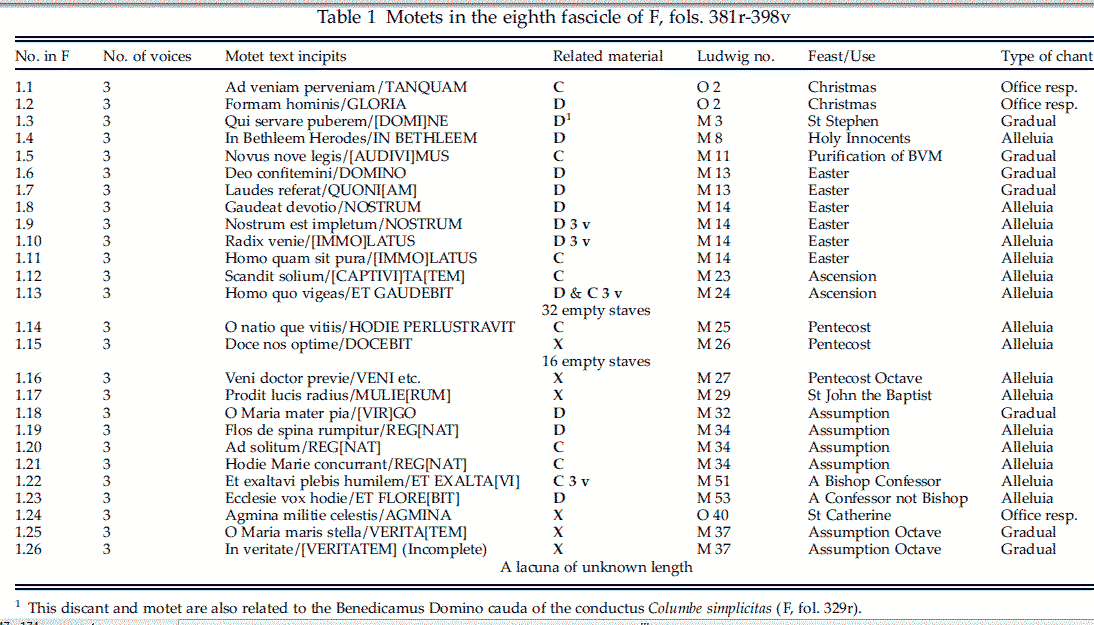 ��fascicle8�ɂ��ā� �@Table 1 shows the sequence of motets in the first motet fascicle of F. Ludwig�fs number for each motet in F is given, followed by the number of voice parts, the motet text incipits and the type of related material in F. C indicates a related clausula in F, D a passage of discant within an organum in F and X shows no extant clausula or discant material in W1, F or W2.Ludwig�fs numbers assigned to chants for the Office (O) and the Mass (M) are provided, in addition to the feast at which this chant is sung,14 and the chant type (Office responsory, gradual responsory, or alleluia).15 �@�@The arrangement of motets in fascicle 8, which appear in the liturgical order of their tenor chants, was undertaken with care. At two junctures (fols. 387r.388v and fols. 389v.390r) a number of staves were left empty, presumably to be later filled with certain motets appropriate to this point in the sequence. The integration of blank staves within the fascicle suggests that the copyist placed much importance on the complete and comprehensive nature of this collection of monotextual motets, and on the order in which the pieces appeared.16 16 Haggh and Huglo have also commented on the presence of empty ruled folios on which no text or music was copied at the end of fascicle 10 in F. See their �eMagnus liber . Maius munus�f, 215. They suggest that the eleven folios of blank staves at the end of this fascicle of monophonic conducti may indicate that the manuscript was compiled quickly in order to be ready for the dedication of the Sainte Chapelle. This does not, however, seem a plausible explanation for the empty staves in fascicle 8. As these blank staves occur mid-fascicle it appears more likely that they were subsequently intended to be filled than that the scribe simply ran out of time. Indeed, one might expect a scribe working under pressured conditions to compromise the comprehensive nature or the ordering of his motet collection, and simply to complete the fascicle with available pieces rather than leaving space for later insertions. �AThe liturgical ordering of fascicle 8 is disturbed only at its conclusion: the final two motets (both on VERITATEM, M37) should strictly have appeared slightly earlier in the fascicle, following other motets on Assumption tenors,17 and the antepenultimate motet for the feast of St Catherine (on AGMINA, O 40) might also have been expected to precede motets for the common of saints (1.22 and 1.23).18 It is striking that these final three motets(1.24.1.26) �| all lacking related materials in W1, F or W2 �|are instead grouped together at the point where the fascicle breaks off.19 �BThe only other motets in fascicle8 lacking extant related materials are also presented in series (1.15.1.17).20 Within the liturgical structure of this fascicle, motets associated with passages of discant within organa in F are, in the main, clustered together (e.g., motets 1.2.1.4, 1.6.1.10 and 1.18.1.19). Similarly, a motet with a corresponding clausula in F is most often found alongside another motet of this type (e.g., motets 1.11.1.14 and 1.20.1.22). This suggests that awareness of the presence and type of related material preserved in F played an additional role in establishing the order in which motets were recorded. �@�@�����̃e�m�[���̓T��I�����Ŗ��炩�ɂȂ�Afascicle 8�ɂ����郂�e�b�g�̔z�u�́A���Ӑ[���s���Ă���B(fols. 387r�|388v ��fols. 389v�|390r)�̍������ł́A�����̕��\�����܂܂ɂȂ��Ă���A�����炭�́A����ɓK���ȃ��e�b�g�������ɓ����\��ł������̂��낤�Ǝv����B���q�����ɋ̕��\���g�ݍ��܂�Ă���̂́A�X�N���C�u���Amonotextual motet�i��conductus motet)�̃R���N�V�����̊��S����I�Ȑ�����A���̍�i���o���������Ԃɑ����̏d�v����u���Ă������Ƃ������Ă���B 16 Haggh and Huglo�́AF�ʖ{����fascicle 10�̍Ō�ɂ����ăe�L�X�g�����y���Ȃ������ɂ��ăR�����g���Ă���B�ނ�́A�u�P����conductus���q�̍Ō�ɂ���eleven folios�����\�́A�ʖ{��Sainte Chapelle�̌������̂��߂ɋ}���ŕҎ[���ꂽ���߂ł��邱�Ƃ������Ă���v�ƒ�Ă��Ă���B����͂������A�M�������������ł���B�����̋��\�͎ʖ{�̐^������ŏo�����Ă���A���L���P���Ɏ��Ԃ��g���ʂ����Ă��܂����ƌ������́A�������������߂�Ӑ}���������ƍl����ׂ��ł��낤�B�����Ƃ��A���L���A���e�b�g�S�̂̐����𗝉������胂�e�b�g�R���N�V�����𒁏��Â�����Ƃ����������Ńv���b�V���[���A��̑}���̂��߂̃X�y�[�X���c���Ă��������ނ���A�𗧂�i�Ƃ��āA�P���ɍ��q�����������悤�Ƃ����̂�������Ȃ����B �Afascicle 8�̓T�珘��́A�����ō����𗈂����Ă���Bthe final two motets (both on VERITATEM, M37)�́A�����Ɍ����AAssumption tenors�������̃��e�b�g�ɏ]���āA���q�̂��������O�Ɏ����ė�����ׂ��ł������B �����āAthe feast of �@St�@Catherine �̂��߂̃��e�b�g(on AGMINA, O 40)���܂��A���ʂ̐��k�����̂��߂̃��e�b�g(1.22 and 1.23)������ɂ���ׂ��ł��낤�B(1.24�|1.26)�̍Ō�̂R�̃��e�b�g�i���ׂĊe�ʖ{�ɑ��Ċ֘A����f�ނ��Ȃ��j���A���q���������_�ŃO���[�v�ɂȂ��Ă��邱�Ƃ͒��ڂ��ׂ����Ƃł���B19 19�@1.24�|1.26 ���O���[�v�������̂́A�����R�̃��e�b�g���ׂĂ��Ђ낭�`�d����Ă������e����̃_�u�����e�b�g�̌`���ł��邽�߂ł���B�P��̎����_�u�����e�b�g���̑��ΓI���n��I�D�揇�������āA�e�ʖ{�̕Ҏ[�҂͂��łɁA��������monotextual motet�i��conductus motet)�������̎��̃o�[�W�����i�_�u�����e�b�g�j�ɂ����݂��邱�Ƃ����ɒm���Ă���A���ꂪfascicle 8�ɂ����ĕ��ׂĔz�u���ꂽ���ƂɊW���Ă���B �Bfascicle8�ɂ����錻������֘A�����f�ށi�N���E�Y����f�B�X�J���g�j�������Ă��鑼�̃��e�b�g��(1.15�|1.17)�ł���B���̍��q�̓T��I�\���ɂ����āA�I���K�k�����f�B�X�J���g�Ɋ֘A�������e�b�g�͎�Ƃ��āA��̂ƂȂ��đ��݂��Ă���(e.g., motets 1.2�|1.4, 1.6�|1.10and 1.18�|1.19)�B���l�ɁA���ʖ{���ɂ����đ�������N���E�Y�������e�b�g�́A���̂������Ɍ��o�����(e.g., motets 1.11�|1.14 and 1.20�|1.22)�B����́A�e�ʖ{���ɕۑ�����Ă����֘A�f���i�N���E�Y����f�B�X�J���g�j�̑��݂Ǝ�ނ̔F�����A���e�b�g���L�^���ꂽ�������m�������ł̒lj��I�������ʂ��������Ƃ������Ă���B 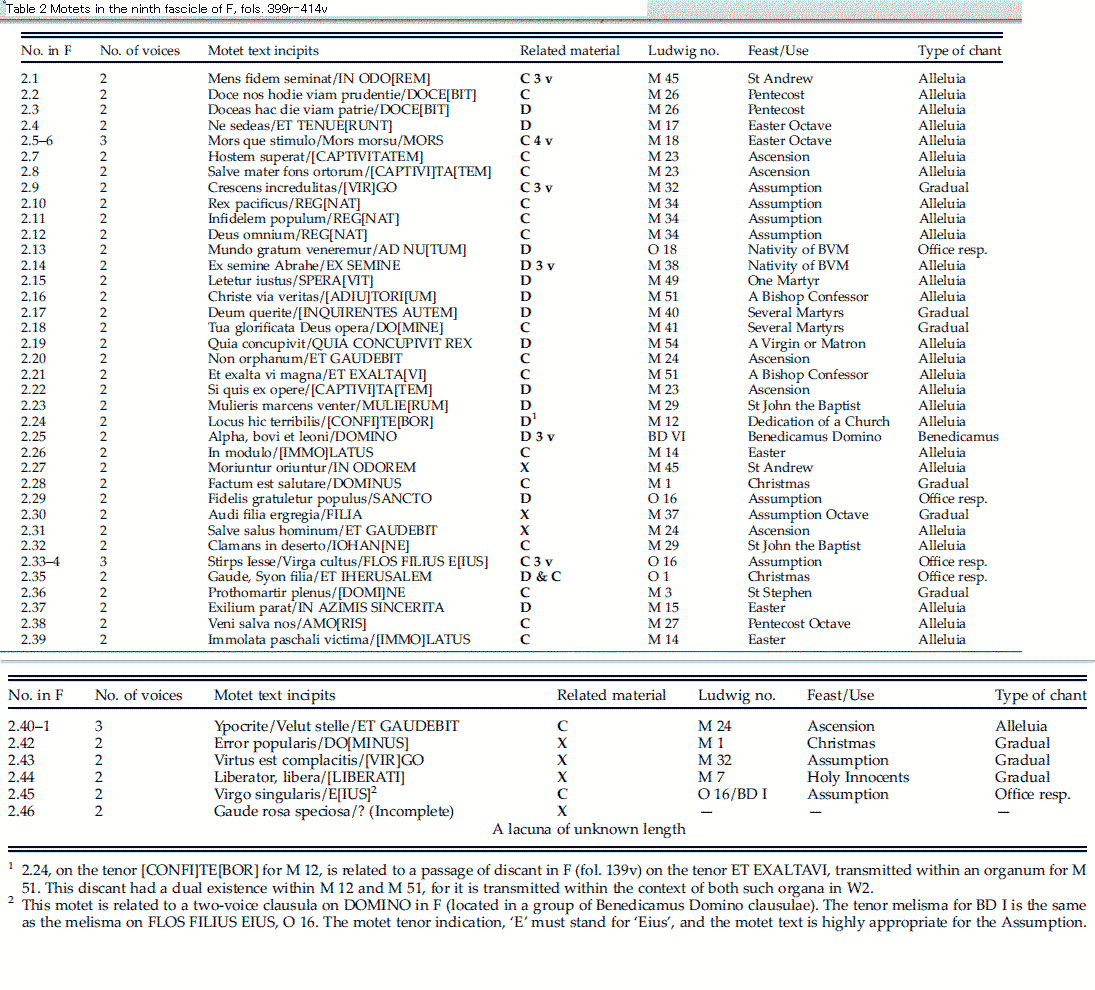 ��fascicle9�ɂ��ā� �@In comparison with the strictly liturgical sequence of the first motet fascicle, the second motet fascicle appears, at first sight, much less meticulously arranged (see Table 2).21 Only a series of fifteen motets, 2.4.2.19, is internally ordered liturgically. This brief sequence begins part-way through the liturgical year, opening with a motet on a tenor chant for M 17 (2.4). �@�ŏ��̃��e�b�g���q�̌��i�ȓT��I����Ɣ�r���āA���Ƃ̃��e�b�g���q�͈ꌩ���āA��蒍�ӎU���ɕ��ׂ��Ă���(see�@Table 2)�B2.4�|2.19�̂P�T�̃��e�b�g�݂̂��A�T��I�ɕ��ׂ��Ă���B���̒Z���i���e�b�g�́j�A���́A�����̓r������n�܂�AM 17 (2.4)�ւ̃e�m�[���`�����g��̃��e�b�g�ƂƂ��Ɏn�܂�B �@Yet, as in the first motet fascicle, the grouping of pieces might reflect an awareness of corresponding musical materials in F. Motets with no extant related clausulae or discant passages in W1, F or W2 are noticeably concentrated in the second half of fascicle 9 (the first such piece is 2.27), often appearing side by-side (e.g., motets 2.30�|2.31 or 2.42�|2.44). Likewise, motets with corresponding clausulae are clustered together throughout (e.g., motets 2.32�|2.36 or 2.38�|2.40.1), as are motets with related passages of discant within organa (e.g., motets 2.22�|2.25). This is particularly evident in the early part of the fascicle: a sequence of seven clausula-related motets (from the double motet 2.5.6 to 2.12) is directly followed by a sequence of five motets with related discant transmitted within organa (2.13�|2.17). �@�ŏ��̃��e�b�g���q�̂悤�ɁA��������A��i�̃O���[�v���́A�e�ʖ{���̉��y�f�ށi�N���E�Y����f�B�X�J���g�j�ɑ����ȔF���f���邩������Ȃ��B�e�ʖ{�ɂȂ�猻������N���E�Y����f�B�X�J���g�������Ȃ����e�b�g�́Afascicle 9�̌㔼���ɏW�����Ă���B�����ΘA�����Č���� (e.g., motets 2.30�|2.31 or 2.42�|2.44)�B���l�ɁA��������N���E�Y���������e�b�g(e.g., motets 2.32�|2.36 or 2.38�|2.40.1)���A�I���K�k�����f�B�X�J���g�Ɋ֘A�������e�b�g(e.g., motets 2.22�|2.25)�Ɠ��l�A�O���[�v�����Ă���B����͓��ɁA���q�̍ŏ��̕����Ŗ��炩�ł���B�N���E�Y���Ɋ֘A�����V�̘A���������e�b�g( 2.5.6�] 2.12)�͒��ځA�֘A�����I���K�k�����f�B�X�J���g�����T�̘A���������e�b�g(2.13�|2.17)�ɏ]����B �����ʖ{�̔�r�� �@�@The two fascicles differ regarding related musical materials in F. Of the twenty six motets in the first motet fascicle, eleven are related to passages of discant transmitted within organa in F, eight to clausulae in F, six have no related materials in F, and one is related to musical material preserved as both a clausula and a passage of discant in F. There is, therefore, a perceptible emphasis on motets with related materials recorded in F as passages of discant within organa, as opposed to independent clausulae. �AIn the second motet fascicle, however, twenty-one of the forty-three motets are related to clausulae in F, fourteen to passages of discant within organa, seven have no related material, and one has related material found as both a clausula and a passage of discant within an organum.22 The majority of motets in this later fascicle, then, have corresponding clausulae in the same source. A general progression from motets associated with passages of discant in F in fascicle 8 to those related to clausulae in F in fascicle 9 might also be perceptible on a more local, internal level. �BTable 3 presents in liturgical order all tenor chants employed in the eighth and ninth fascicles of F. Corresponding motets on each chant are indicated by their numbers and listed in the sequence in which they appear in F.23 The presence and type of associated materials as found in W1, F and W2 is also shown, where a dash indicates no related material in W1 or W2. Motet numbers for the ninth fascicle and their related materials are italicised, and tenor chants first represented in fascicle9 are italicised and underlined. �@�@�e�ʖ{���̉��y�f�ށi�N���E�Y����f�B�X�J���g�j�Ɋ֘A���A��̍��q�ɂ͈Ⴂ������Bfascicle 8��26�̃��e�b�g�̂�����11�̃��e�b�g�̓I���K�k�����f�B�X�J���g�ɊW���Ă���B�U�̃��e�b�g�͂e�ʖ{���Ɋ֘A�����f�ނ������Ȃ��B����ɂЂƂ̓N���E�Y���ƃf�B�X�J���g�̗����Ɋ֘A�����Ă���B����䂦�A�Ɨ������N���E�Y���ɑR���āA�I���K�k�����f�B�X�J���g�Ƃ���F�ʖ{�ɋL�^���ꂽ�֘A�f�ނ��܂ރ��e�b�g�ɂ��Ȃ�̗͓_���u����Ă���B �Afascicle 9�ł͂������Ȃ���A43�̃��e�b�g�̂����Q�P���N���E�Y���ɊW���Ă���B14�̃��e�b�g�̓I���K�k�����f�B�X�J���g�Ɋ֘A���A�ЂƂ��N���E�Y���ƃf�B�X�J���g�̗��҂Ɋ֘A���Ă���B���̑����q���̃��e�b�g�̔������x�́A��������N���E�Y���������Ă���Bfascicle 8���i�I���K�k�����j�f�B�X�J���g�Ɋ֘A���郂�e�b�g����Afascicle 9�̃N���E�Y���Ɋ֘A���郂�e�b�g�ւ̈�ʓI�Ȑi�W���܂��A���Ǐ��I�ȓ������x���ł��Ȃ�킩��悤�ɂȂ��Ă���B �BTable �R�́A��8�C9���q�ɂ�����T�珇���ɏ]�������ׂẴe�m�[���`�����g�������Ă���B�e�`�����g�ɑΉ����郂�e�b�g�́A���̐����ɂ���Ď�����AF�ʖ{�Ɍ���鏇���ŗ���Ă���BW1�AF�����W2�ʖ{�ɑ��݂���֘A�f�ނ̑��݂���у^�C�v��������Ă���A�_�b�V���|��W1�܂���W2�Ɋ֘A����f�ނ��Ȃ����Ƃ������B fascicle �X�Ƃ��̊֘A�f�ނ̃��e�b�g�ԍ��̓C�^���b�N�̂ɂȂ��Ă��āAfascicle �X�ŏ��߂ďo������e�m�[���̃`�����g�̓C�^���b�N�̂ʼn�����������Ă���B 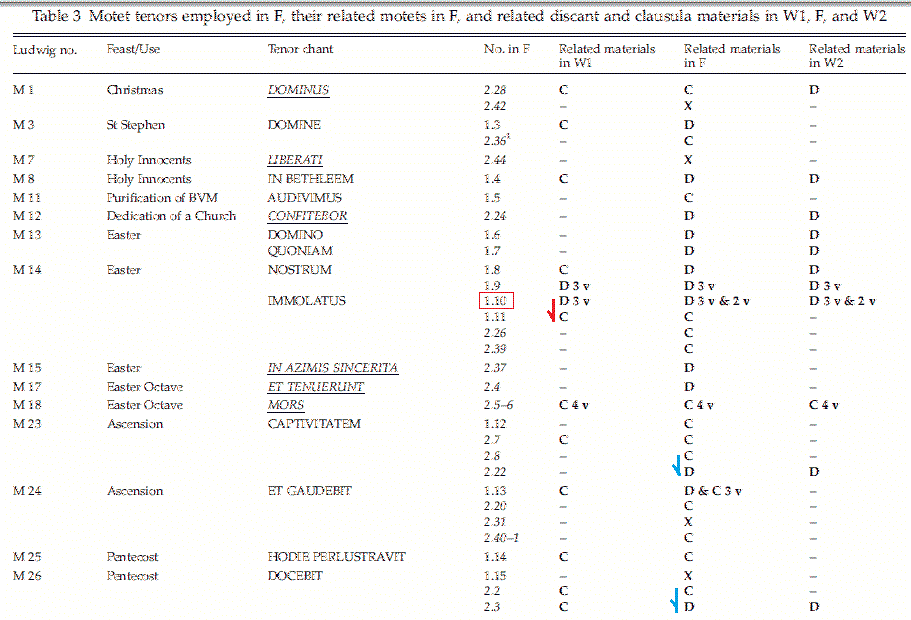 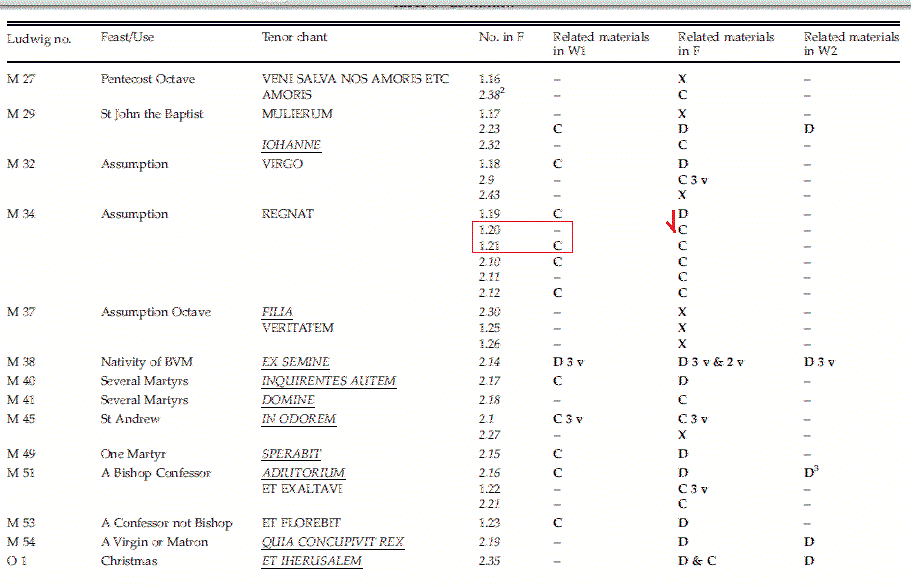 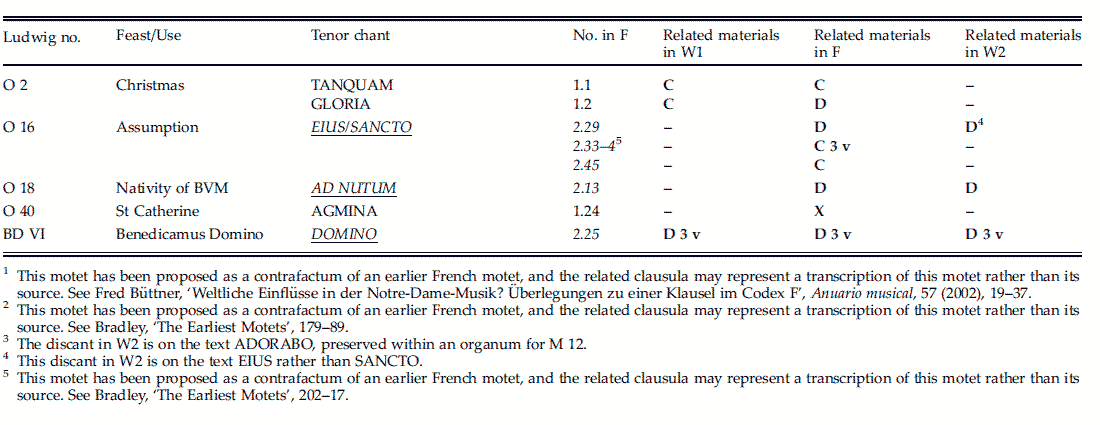 �@�@When a number of motets on the same tenor chant are recorded in fascicle 8, motets with corresponding clausulae in F invariably appear after a motet on the same tenor related to a passage of discant within an organum in F. Thus, 1.10 on the tenor [IMMO]LATUS (M 14) is associated with a passage of discant in F, and is followed by 1.11, on the same tenor, but with a corresponding clausula in F. Likewise, the two clausula-related motets on the tenor REG[NAT] (M 34), 1.20 and 1.21, follow a motet on this tenor, 1.19, associated with a passage of discant in F. �A This pattern is continued in fascicle 9, where motets related to clausulae are overwhelmingly on tenors for which fascicle 8 has already provided. Discant-related motets on the tenors REG[NAT] (M 34) and [IMMO]LATUS (M 14) appear in the first motet fascicle; the second provides a further three motets, all with related clausulae, on the Assumption tenor REG[NAT], and a further two motets, both with related clausulae, on the Easter tenor [IMMO]LATUS. Indeed, out of the twenty-one motets in fascicle 9 associated only with clausulae in F, just five (2.1, 2.5.6, 2.18, 2.28 and2.32) are on tenor chants (for M 45, M 18, M 41, M 1 and M 29, respectively) that are neither represented in fascicle 8, nor already furnished with a discant-related motet in fascicle 9. �@�@�����e�m�[���`�����g�̃��e�b�g�̔ԍ��� fascicle 8���L�^����Ă���ƁAF�ʖ{���̃N���E�Y���ɑΉ����郂�e�b�g�́A�K��F�ʖ{�̃I���K�k�����f�B�X�J���g�Ɋ֘A���铯���e�m�[���̃��e�b�g�̌�Ɍ�����iD��C�j�B����䂦�ɁA�e�m�[�� [IMMO]LATUS (M 14)��̃��e�b�g1.10 �́A�e�ʖ{���̃I���K�k�����f�B�X�J���g�Ɋ֘A���Ă���B�����ē����e�m�[��������1.11�Ƀt�H���[����邪�A��������N���E�Y���Ƃ��֘A����B���l�ɁA1.20��1.21�́A�e�m�[��REG[NAT] (M 34)��ŃN���E�Y���Ɋ֘A�����Q�̃��e�b�g�́A�f�B�X�J���g�Ɋ֘A���铯���e�m�[��������1.19�̌�ɏ]���B �GD��C�i�f�B�X�J���g���N���E�Y���j�̓��e�b�g�̐i�������� �A���̃p�^�[���́Afascicle 9�ł������p����Ă���B�����ɂ����ẮA�N���E�Y���Ɋ֘A�������e�b�g�́A���ł�fascicle 8���������Ă����e�m�[�������|���Ă���B�e�m�[��REG[NAT] (M 34)�� [IMMO]LATUS (M 14)����f�B�X�J���g�֘A���e�b�g�́Afascicle�W�Ɍ���邪�A���V���e�m�[��REG [NAT]�́A����fascicle�X�ɂ���ɂR�̃��e�b�g����Ă���i���ׂĂ��N���E�Y���Ɋ֘A�j�B�����fascicle�X���A�֘A����N���E�Y���܂ށA�C�[�X�^�[�̃e�m�[��[IMMO]LATUS���2�̃��e�b�g�����^���Ă���B�N���E�Y���Ɋ֘A����fascicle 9���Q�P�̃��e�b�g�̂����ŁA2.1, 2.5�|6, 2.18, 2.28�A2.32�̂T�̃��e�b�g�́A���ꂼ�� M 45, M 18, M 41, M 1�A M 29�ɑ���e�m�[���`�����g��ɂ���B������fascicle 8�ɂ͂Ȃ��Afascicle 9�ɂ�����f�B�X�J���g�֘A���e�b�g�ɂ�������Ă��Ȃ������B �@�@By contrast, twelve out of the fifteen motets in fascicle 9 with corresponding passages of discant within organa in F are on previously unrepresented tenors. Only three of these fifteen motets employ tenor chants already provided with motets in the eighth fascicle: 2.3, 2.22, and 2.23. Significantly, none of the fascicle 8 motets on these tenors (DOCEBIT, M 26; CAPTIVITATEM, M 23; MULIERUM, M 29; respectively) were associated with passages of discant within organa. �A Thus all fifteen of the discant-related motets in the ninth fascicle are on tenor chants for which no discant-related motet is recorded in the eighth fascicle. Furthermore, of the nineteen tenor chants making their first appearance in the second motet fascicle (shown in italics and underlined in Table 3), the majority (twelve) have corresponding passages of discant within organa. Just five of these tenors are first represented by motets with related clausulae, and only two (for M 7 and M 37) by motets with no clausulae or discant materials. �@�@�ΏƓI�ɁAfascicle 9���̃I���K�k�����f�B�X�J���g�ɑ�������P�T�̃��e�b�g�̂����̂P�Q�́Afascicle�W�ɂ͑��݂��Ă��Ȃ������e�m�[����ɂ���B�c��̂R�i2.3, 2.22, 2.23�j�̃��e�b�g�́A���ł�fascicle �W���̃��e�b�g�ɂ����ċ�������Ă���B�d��Ȃ��Ƃ́Afascicle �W���̂��̎c��̂R�̃��e�b�g�ɑ���e�m�[��(DOCEBIT, M 26; CAPTIVITATEM, M 23; MULIERUM, M 29�j�̓I���K�k�����f�B�X�J���g�Ɗ֘A���Ă��Ȃ����Ƃł���B �A�䂦�ɁAfascicle �X���̂P�T�̃f�B�X�J���g�֘A���e�b�g�̂��ׂẮAfascicle �W�ł̓f�B�X�J���g�֘A���e�b�g�Ƃ��ċL�^����Ă��Ȃ��`�����g���g���Ă���B����ɁAfascicle �X�ɂ����ď��߂Č����P�X�̃e�m�[���̂����A�A�����i�P�Q�j�̓I���K�k�����f�B�X�J���g�ɑ�������p�b�Z�[�W�������Ă���B�����e�m�[���̂����̂T�́A�֘A����N���E�Y�������������e�b�g�ł���A�Q��(M 7 M 37)�̓N���E�Y�����f�B�X�J�E���g�f�ނ��Ȃ����e�b�g�ł���B �@�@In summary, there is a predominance of motets related to passages of discant within organa in F in fascicle 8, while the majority of motets in fascicle 9 are related to clausulae in F. In addition, almost all of the motets related to passages of discant within organa in the ninth fascicle are on tenor chants unrepresented in the eighth. The motets in fascicle 9 for previously represented feasts, by contrast, usually have related clausulae in F. Of the forty different tenor chants employed in the motet fascicles of F, the majority (twenty-six) have at least one motet with a corresponding passage of discant within an organum in F.24 �AOn only two occasions (both in the second motet fascicle, on the tenors CAPTIVITATEM, M 23 and DOCEBIT, M 26)does a discant-related motet appear after a motet with an associated clausula presented earlier in the same fascicle. Most often, therefore, at least one motet related to a passage of discant within an organum in F is provided for each tenor chant, usually presented before any motets with corresponding clausulae in F or lacking related materials. ���܂Ƃ߁� �@�@�܂Ƃ߁Bfascicle 8�ɂ����ẮA�I���K�k�����f�B�X�J���g�Ɋ֘A�������e�b�g���x�z�I�ł��邪�Afascicle �X�̃��e�b�g�̑����̓N���E�Y���Ɋ֘A�����B����ɉ����āAfascicle �X�̃I���K�k�����f�B�X�J���g�ɊW���郂�e�b�g�̑啔���́Afascicle 8�ł͈����Ă��Ȃ��e�m�[���`�����g��ɂ���B fascicle �X���̃��e�b�g�͂��Ƃ��Ƃ́i�C�[�X�^�[�̂悤�ȁj�j�Ղ�S�����Ă������AF�ʖ{���̃N���E�Y���Ɗ֘A������BF�ʖ{�̃��e�b�g���q���ɂ���S�O�̃e�m�[���`�����g�̂����A���Ȃ�̐��i�Q�U�j�͏��Ȃ��Ƃ��I���K�k�����f�B�X�J���g�ɑ�������ЂƂ̃��e�b�g�������Ă���B�Q�S �Q�SThis is all the more significant given that clausulae in F vastly outnumber passages of discant within�@organa. ����́AF�ʖ{����clausulae���I���K�k����discant�̃p�b�Z�[�W��啝�ɏ������Ƃ��l����ƁA���d�v�ł���B �A�ӂ��̃��e�b�g (both in the�@second motet fascicle, on the tenors CAPTIVITATEM, M 23 and DOCEBIT, M 26)�ɂ������̂��A�f�B�X�J���g�ɊW���郂�e�b�g���A�������q���̂�葁���̃N���E�Y���ɊW���郂�e�b�g�́h��Ɂh�o�����Ă���B����䂦�A�قƂ�ǂ̏ꍇ�́A�I���K�k�����f�B�X�J���g�ɊW���郂�e�b�g���A�N���E�Y���ɊW���邠�邢�͊֘A����f�ނ̂Ȃ����e�b�g�̈ȑO�i�̏�ԁj�������Ă���B �@The progression from motets associated with passages of discant within organa in F to those with corresponding clausulae can be seen particularly clearly in the case of the two most heavily represented feasts in the motet fascicles of F: Easter and Assumption, both of the highest rank of annual feasts (along with Christmas and Pentecost) in the Notre Dame calendar.25 Tables 4 and 5 present the motets that could be sung at Mass on Easter Day, and at the Office and Mass on the feast of the Assumption respectively, grouping them under Ludwig�fs numbers for the Office and Mass chants in the order in which they are arranged in F.26 �@�I���K�k�����f�B�X�J���g�Ɋ֘A���郂�e�b�g����N���E�Y���ɊW���郂�e�b�g�ւ̐i���́AF�ʖ{���̃��e�b�g���q�ɂ����āA�C�[�X�^�[�⏸�V���̂悤�ȑ傫�ȏj�Ղ�S������P�[�X�ɂ͂�����ƌ��Ď���B  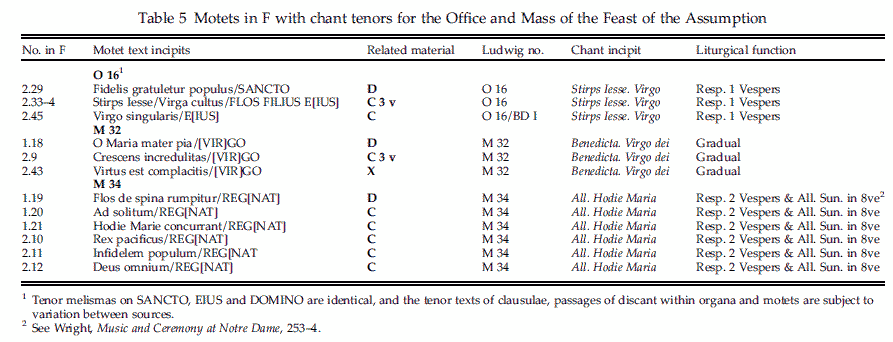 �@It appears that such patterns in the ordering of motets in F are not purely coincidental, but were deliberately created and cultivated by those compiling the motet collections in this manuscript. As already noted, the presentation of musical material in the form of either a passage of discant within an organum or a clausula can vary slightly between manuscript sources. If the motet fascicles of F are arranged with a view to the presence, absence and type of related material in the same manuscript, then the order in which the motets appear must be, to some extent, specific to this source. Were these pieces to have been copied from an existing motet collection already in this order, then it is unlikely that concordances with material which had the particular status of clausulae or passages of discant within organa in F should match up so neatly.27 �@F�ʖ{���̃��e�b�g�̏����p�^�[���������ċ��R�ł͂Ȃ��A�n�l���ꂽ���̂ł��邱�Ƃ͖��炩�ł���B���łɌ����悤�ɁA�I���K�k�����f�B�X�J���g��N���E�Y���̌`���ɂ����鉹�y�f�ނ̏́A�ʖ{�Ԃɂ����Ď�ω����Ă���BF�ʖ{���̃��e�b�g�̏����p�^�[���������ċ��R�ł͂Ȃ��A�n�l���ꂽ���̂ł��邱�Ƃ͖��炩�ł���B ���łɌ����悤�ɁA�I���K�k�����f�B�X�J���g��N���E�Y���̌`���ɂ����鉹�y�f�ނ̏́A�ʖ{�Ԃɂ����Ď�ω����Ă���B������F�ʖ{���̃��e�b�g���q���A�����ʖ{���̊֘A����f�ނ̑��݁A�s�݁A����ю�ނ��l�����Ĕz�u����Ă���̂ł���A���e�b�g���\������鏇���́A������x�͂��̃\�[�X�ɘA�ւ��Ă����Ȃ���Ȃ�Ȃ��B��������i�Q���������������ł��łɑ��݂��Ă��郂�e�b�g�R���N�V��������ʕ����ꂽ�̂ł���A�I���K�k�����f�B�X�J���g��N���E�Y���̓���ȏ�ԂɊW����f�ނ̈�v���ƂĂ����܂��������Ƃ͂��蓾�Ȃ����Ƃł��낤�B27 27 Roesner is also of the opinion that the first fascicle of motets was compiled for F, observing that �ethe irregularities in copying towards the end of the collection in fascicle 8 [presumably the unfilled staves] suggest . . . that this cycle was only then in the process of being compiled�f. Introduction to the �eNotre-Dame Manuscript�f F, 29. �@�@An arrangement of the motet fascicles accounting for related musical materials in the same source would be consonant with the state of the contents of F more generally, characterised by Roesner as �ehighly organized, with several modes of organization operating simultaneously�f.28 F avoids any duplication of material within or across the two motet fascicles, while in W2 (the four motet fascicles of which were the work of three different scribes) the same motet can reappear in a different guise in a new fascicle.29 �AIn F, it is striking that two two-voice motets on Pentecost tenors (2.2 and 2.3)�| precisely the feast for which provision seems to have proved problematic in fascicle 8, where empty staves were left unfilled�\are copied almost immediately at the beginning of fascicle 9.30 This points towards an awareness of material across the motet fascicles. Given that the entire contents of F, unlike W2, were copied by a single music scribe, such consciousness of the motet collection as a whole is perhaps unsurprising. And it is plausible that this consciousness extended also to the manuscript as a whole, encompassing related musical materials in the form of both clausulae and passages of discant within organa. �@�@�����\�[�X�Ɋ֘A���鉹�y�f�ނ��������e�b�g���q���z����A����ʓI�ɂ́ARoesner�ɂ���āu���x�ɑg�D������A�������̑g�D�`�Ԃ������ɓ��삵�Ă���v�Ɠ����Â�����F�ʖ{�����e�ƈ�v�����B28�@ F�ʖ{�͓�̃��e�b�g���q�ɋ��ʂ���f�ނ̏d���͔����Ă���B����ɂ����āAW2�ʖ{�i����4�̃��e�b�g���q��3�l�̏��L�ɂ���ď�����Ă���j�ł́A�������e�b�g���V�������q���ňقȂ��������̒��ōČ������B29. �@ �AF�ʖ{�ł́A����~�Փ��̃e�m�[����̓��2���̃��e�b�g�i2.2��2.3�j���A�\����͂܂��ɁA�̂��镈�\������fascicle 8�ł́A���̂��߂̏��������Ƃ���Ă����j�Փ��ł���\fascicle 9�̍ŏ����Ŏʕ�����Ă��邱�Ƃ���ۓI�ł����B����́A���e�b�g���q�ɋ��ʂ̑f�ށi�N���E�Y����f�B�X�J���g�j�ւ̔F�����w�������BW2�ʖ{�ƈقȂ��āAF�ʖ{�̑S�̂̓��e����l�̏��L�҂ɂ���ď����ꂽ�̂ł���A�T���āA���e�b�g���W�̈ӎ��i�̍����j�͋����ׂ����Ƃł͂Ȃ����낤�B�����āA�S�̂Ƃ��āA�I���K�k�����f�B�X�J���g�ƃN���E�Y�����҂̌`���ɂ����āA�֘A�������y�f�ނ�ԗ��������������ӎ����ʖ{�֊g�債�����Ƃ͂��蓾�邱�Ƃł���B The proposed arrangement of motets in F might prove revealing in terms of their possible function. Clearly, the organisation of motets according to the liturgical calendar alone need not necessarily indicate a liturgical performance context. What survives of the manuscript Mu�N A, for example, demonstrates that the arrangement of its motets depended on their tenor chants. But the inclusion of both Latin and French motets within a liturgically ordered sequence suggests that the grouping of motets by tenor according to the Church calendar was, in this case, more an abstract organisational principle than evidence of liturgical performance.31 �@F�ʖ{�ɂ����郂�e�b�g�̒�Ă��ꂽ�z��́A�����̉\�ȋ@�\�̓_�Ŗ��炩�ɂȂ��Ă���ł��낤�B���炩�ɁA�����ɏ]�����e�b�g�̑g���͕K�������T����H�̓��e���܂ޕK�v�͂Ȃ��BMu�N A�ʖ{�Ɏc���Ă�����̂́A���Ƃ��A���e�b�g�̏��e�m�[���`�����g�Ɉ˂��Ă��邱�Ƃ������Ă���B�������A�T�璁���ŕ����e����ƃt�����X�ꃂ�e�b�g�̕�܂́A�����ɏ]�����e�m�[���ɂ�郂�e�b�g�̃O���[�v�������A���̃P�[�X�ɂ����ẮA�T��I���H�̏؋������������ꂽ�g�D�����ł��������Ƃ������Ă���B �@�@The motet fascicles of F, largely arranged according to the liturgical calendar, betray other signs of possible liturgical influence. The initial twenty-three motets of fascicle 8 basically cover the church year, providing one motet for each tenor chant, and duplicating only motets on the tenors NOSTRUM, [IMMO]LATUS and REG[NAT], for two of the annual feasts, Easter and the Assumption respectively. �AFascicle 9 supplements these important feasts, expanding the motets for Christmas and Pentecost, while also offering motets on tenors for lesser feasts absent from the eighth fascicle, and, in particular, for the Common of Saints (see the tenor chants first represented in the ninth fascicle, as highlighted in Table 3). The relatively small number of motets for the Christmas season (with just two motets for M 1, two for O 2 and two for the feast of St Stephen, M 3) might seem contrary to the liturgical importance of this time. However, this could easily be explained, as proposed by Arlt in his unpublished 1985 paper, by the suggestion that the need for such motets was limited, given the rich provision of music for Christmas and the feast of St Stephen elsewhere in the Magnus liber, including the famous four-voice Viderunt and Sederunt organa. Finally, the sheer number of different tenor chants represented in F (forty different tenors in sixty-nine motets) may indicate that the motet collection attempted to furnish quite a wide range of liturgical feasts with appropriate settings. �@�@F�ʖ{���̃��e�b�g���q�́A�T���ɂ���đ�K�͂ɔz��Ă��āA�T��̉e������̑��̒���͌����Ȃ��Bfascicle 8 �̍ŏ��̂Q�R�̃��e�b�g�͊�{�I�ɂ́A����N���J�o�[���A��̃e�m�[���`�����g�ɑ��Ĉ�̃��e�b�g���������Ă���B�����āA�e�m�[��NOSTRUM, [IMMO]LATUS and REG[NAT],REG[NAT]�݂̂��A���e�b�g�ɂ����ďd�����p����Ă���B���ꂼ����������Ə��V���̂��߂̂��̂ł���B �AFascicle 9�́A����ɃN���X�}�X���~�Փ��ɂ����e�b�g���g�債�āA���������d�v�ȏj�������Ă���Bfascicle 8�ł͌����Ȃ����j���̂��߂̃e�m�[�����g�������e�b�g���܂����Ă���B���ɁACommon of Saints�̋V���̂��߂ɁB�N���X�}�X�V�[�Y���̂��߂̂��ꂼ��̏����̃��e�b�g �itwo for M1 two for O 2 and two for the feast of St Stephen, M 3)�́A���̎���̓T��I�d�v���Ƃ͑���������̂ł��邩������Ȃ��B�������Ȃ���A����͗e�Ղɐ������邱�Ƃ��ł���BArlt�ɂ����1985�N�ɔ��\���ꂽ�i�o�ł͂���Ȃ������j�_���ɂ��A�L����4����Viderunt �� Sederunt ���܂�Magnus liber�̑��̂Ƃ���ł��N���X�}�X��X�e�t�@�m�̏j���̂��߂̉��y�̖L�x�Ȓ��l����ƁA�����������e�b�g�ւ̃j�[�Y�͌����Ă������Ƃ���Ă���Ă���B�Ō�ɁAF�ʖ{���̈قȂ����e�m�[���`�����g�̏����Ȑ� (forty different tenors in sixty-nine motets) ���A���e�b�g�R���N�V�������K�x�Ȕz�u�ɂ���ēT��j���̕��L���͈͂ɔ����悤�Ƃ��Ă������Ƃ������Ă���B �@�@Given that organa and clausulae are thought to have been performed liturgically, a seeming preoccupation with their relationship to the motets in F might point towards the use of motets in the liturgy, and the precedence given to motets related to passages of discant in F could reflect a liturgical concern. It is generally accepted that clausulae were intended for substitution into organa, yet they must have had additional functions or performance contexts. �AThere are, for example, a number of clausulae in F lacking host organa in the same source,32 or on tenors drawn from the choral portions of responsory melismas that were not normally set polyphonically.33 �@Liturgical usage seems unlikely for the famous NUSMIDO clausula (F, fol. 150v), which presents its DOMINUS tenor in retrograde, and might be more plausibly understood as an ingenious musical pun. Certain clausulae in F have, furthermore, been identified as transcriptions of French motets containing widely cited refrain melodies, casting doubt on their liturgical suitability, and raising questions about their purpose.34 Thus, while there is little reason to doubt that passages of discant within organa were performed in a liturgical context, the liturgical status of clausulae is occasionally more ambiguous. The primary provision of motets with corresponding passages of discant within organa in F might, then, reflect the closer ties of this musical material to a liturgical context. 32 See the discussion of two-, three- and four-voice clausulae lacking host organa in Hans Tischler, �eHow Were Notre Dame Clausulae Performed?�f, Music and Letters, 50 (1969), 273?7, at 274?5. It is, however, possible that clausulae lacking host organa were still performed liturgically, simply inserted into a host chant rather than into a polyphonic organum. 33�@For instance, two neighbouring clausulae �\on the tenors CLEMENTIA[M] (F, fol. 184r�]v), from the responsory Qui cum audissent for St Nicholas (O 25a), and TE (F, fol. 184v), from the responsory Sancte Paule Apostole V. Ut digni (O 4a) for St Paul the Apostle �\employ chant melismas from the choral portions of their host responsories. ���Ƃ��A�ӂ��ׂ̗肠�����N���E�Y�� (F, fol. 184r�]v)(F, fol. 184v)�́\1�̓e�m�[��CLEMENTIA[M] ��́A�����P���e�m�[��TE ��̂��́A�O�҂�responsory Qui cum audissent for St Nicholas (O 25a)����A��҂�responsory Sancte Paule Apostole V. Ut digni (O 4a) for St Paul the Apostle�����\������host responsorium�̍��������̃����X�}���g���Ă���B�@ 34�@Gordon A. Anderson initially rejected the hypothesis that clausulae in F might be transcriptions of motets; see his �eClausulae or Transcribed Motets in the Florence Manuscript?�f, Acta musicologica, 42 (1970), 109.28. However, Wolf Frobenius, in �eZum genetischen Verha�Nltnis zwischen Notre-Dame-Klauseln und ihren Motetten�f, Archiv fu�N r Musikwissenschaft, 44 (1987), 1.39, declared a majority of clausulae with related motet versions to have originated as motets. Frobenius�fs general reversal of the traditional clausula.motet relationship was not widely accepted. See, for example, Norman E. Smith, �eThe Earliest Motets: Music and Words�f, Journal of the Royal Musical Association, 114 (1989), 141.63, at 145.6. Yet a small number of clausulae in F have recently been re-proposed as transcriptions of French motets. See Fred Bu�N ttner, �eWeltliche Einflu�N sse in der Notre-Dame-Musik?�f Anuario musical, 57 (2002), 19.37; Bradley, �eThe Earliest Motets�f, 179.226. �@�@�������I���K�k���ƃN���E�Y�����T��I�Ɏ��H����Ă����̂ł���AF�ʖ{���̃��e�b�g�̊W�ւ̐���ς̂悤�Ȃ��̂́A�T��ɂ����郂�e�b�g�̎g�p�ւƌ��������Ƃ��낤�B�����āA�f�B�X�J���g�Ɋ֘A�������e�b�g�ɗ^����ꂽ�D�揇�ʂ́A�T��I�ȊS�f���邱�Ƃ��낤�B�N���E�Y�����I���K�k���ւ́h��ցh������Ӑ}�������Ă������Ƃ͈�ʓI�Ɏ�e����Ă���A�����͕t���I�@�\����H�I���e�������Ă����ɈႢ�Ȃ��B �A�Ⴆ�AF�ʖ{���ɂ́A�����\�[�X�̒��ŁA�z�X�g�I���K�k���������Ă��鑽���̃N���E�Y��������B32�@ 32�@�z�X�g�I���K�k���������Ă���N���E�Y���͂��̂܂ܓT��Ŏg���A�|���t�H�j�[�I���K�k���ɑ��Ă����A�z�X�g�`�����g�ւƒP���ɑ}�����ꂽ�B ���邢�́A�ʏ�̓|���t�H�j�[�Ƃ͂Ȃ�Ȃ�responsory melismas�̍����������玝���Ă���ꂽ�e�m�[�����g���������̃N���E�Y��������B33�@�e�m�[��DOMINUS �̓ǂ݂���O��łЂ�����Ԃ����e�m�[��NUSUMIDO��̗L���ȃN���E�Y��(F, fol. 150v)�ɑ��ẮA�T��I�Ȏg�p�͍l���ɂ����B�P�ɁA�Ƒn�I�ȉ��y��̃_�W�����Ƃ��ĂȂ�A���[���̂����������ł��邩������Ȃ��B F�ʖ{���̂����̃N���E�Y���͂���ɁA�������ꂽ�����������������f���̕��L�����p���܂�A���̓T��I�K�����ւ̋^������������A���������ړI�ɋ^�₪����悤���t�����X�ꃂ�e�b�g�����transcription�Ƃ��ē��肳�ꂽ�肵�Ă���B34�@ 34�@Gordon A. Anderson �͂��Ƃ��ƁAF�ʖ{���̃N���E�Y�������e�b�g�����transcriptions �ł��邾�낤�Ƃ������������ۂ��Ă���B�������AWolf Frobenius�́A�N���E�Y���̑啔���́A���e�b�g�Ƃ��Ă̋N�������A�Ɛ錾���Ă���BFrobenius�̓`���I�ȃN���E�Y���ƃ��e�b�g�̊W�ɂ��Ă̋t�z�́A�L��������Ă͂��Ȃ��BF�ʖ{���̐����Ȃ��N���E�Y���́A�t�����X�ꃂ�e�b�g�����transcriptions�ł��邱�Ƃ��A�ŋ߁A�ēx��Ă���Ă���B ����䂦�A�I���K�k�����f�B�X�J���g���T��̒��Ŏ��H���ꂽ���Ƃւ̋^���͂قƂ�ǂȂ����A�N���E�Y���̓T��I�Ȓn�ʂ͎��Ƃ��āA���ɂ����܂��ł���BF�ʖ{���̃I���K�k�����f�B�X�J���g�Ɋ֘A���郂�e�b�g��primary provision�́A�T��ł̎��H�Ɖ��y�f�ށi�N���E�Y����f�B�X�J���g�j�ٖ̋��Ȍ��т��f���Ă���B �@�@That motets could actually have been sung within organa, in place of passages of discant or of substitute clausulae, would further explain the ordering of the collection in F. Though there has been little detailed consideration of the practicalities of such a performance practice, it is generally accepted as a possibility.35 Baltzer has drawn attention to the �esectionalized�f nature of organa, which encourages a �epasticcio treatment�f, concluding that the substitution of a motet for a discant passage �ewould not have posed insurmountable difficulties to singers experienced in this repertory�f.36 �AAn important piece of potential evidence to support the hypothesis is offered by the Copenhagen fragment (K), discovered in the 1980s. K contains a copy of an organum for the Easter Day Alleluia (M 14), with the words �eGaudeat devocio�f�|the opening of the motet related to this passage of discant on NOSTRUM�|copied at the beginning of the discant between the tenor and duplum staves (fol. 4r).37 35 See Lefferts and Sanders ,�eMotet, ��I: Middle Ages�f, where it is suggested that the earliest motets �emay have been used within their appropriate organa�f. See also Wright, Music and Ceremony at Notre Dame,342-4. 37 John Bergsagel concluded that this rubric might indicate the chronological priority of the motet over its related discant, possibly providing evidence to support the then recent proposals by Frobenius (�eZum genetischen Verha�Nltnis�f). Bergsagel, �eThe Transmission of Notre-Dame Organa in Some Newly-Discovered �e�eMagnus liber organi�f�f Fragments in Copenhagen�f, in Atti del xiv congresso della societa` internazionale di musicologia: trasmissione e recezione delle forme di cultura musicale, ed. Angelo Pompilio et al., 3 vols. (Turin, 1990), 3:629.36, at 634.5. �@�@���e�b�g�����ہA�f�B�X�J���g���փN���E�Y���̃p�b�Z�[�W�����݂����ŃI���K�k���ƂƂ��ɂʼn̂�ꂽ���Ƃ́AF�ʖ{���̃R���N�V�����̔z�炳��ɐ�������邩������Ȃ��B�����������H�̎������͂قƂ�Ǎl���̗]�n�͂Ȃ���������Ȃ����A�\���Ƃ��Ă͎�����Ă���B35 35�@�ŏ����̃��e�b�g�́A�K����organa�ƂƂ��Ɏg��ꂽ�BWright, Music and Ceremony at Notre Dame,342-4. Baltzer�́A�I���K�k���̎���sectionalize�Ȑ����ɒ��ڂ����B����́h�����I�戵���h�����サ�A�f�B�X�J���g�p�b�Z�[�W�ɑ��郂�e�b�g�̑�ւ��A���̃��p�[�g���[���o�������̂���ɍ����ł��Ȃ�����������炷���ƂɂȂ邾�낤�B �A���̉����i���e�b�g�����ہA�f�B�X�J���g���փN���E�Y���̑��݂���I���K�k�����ʼn̂�ꂽ�j���x��������ݓI�؋������d�v�ȍ�i���A1980�N��ɔ������ꂽK�ʖ{�iCopenhagen fragment �j�ł���BK�ʖ{�́A�f�B�X�J���g�̍ŏ��́A�e�m�[����duplum�̃X�R�A�̊ԂɕM�ʂ���Ă���eGaudeat devocio�f�Ƃ������t�i�e�m�[��NOSTRUM��̃f�B�X�J���g�Ɋ֘A�������e�b�g�̍ŏ��j��Easter Day Alleluia (M 14)�̂��߂̃I���K�k�����܂�ł���B �@�@However, the evidence of this fragment and the likely performance of motets within organa are questionable on several counts. It is difficult to judge the extent to which K might represent a widespread practice, and the presence of a motet incipit within an organum could serve merely as an indication that there was a motet text associated with this music rather than a performance direction. Significantly, two motets recorded in F lack appropriate host organa in the same source. Motet 1.24, Agmina militie celestis/AGMINA (fols. 396v.397v) for the feast of St Catherine (O 40), employs a melisma from the responsory Virgo flagellatorV. Sponsus amat that, as a non-soloistic part of the chant, is not furnished with polyphony in the three�@voice organum setting of this responsory.38 38�@ Motet 1.24 could be performed within the two-voice organum for the Alleluia Corpus beate virginis (M 65) found in StV (fol. 286v), the only extant organum to set polyphonically the melisma on Agmina. Friedrich Ludwig named M 65 as the source of the Agmina melisma; see Repertorium I/1, 107. In his 2011 edition of this motet, Thomas Payne gave both M 65 and O 40 as possible chant sources (Philip the Chancellor: Motets and Prosulas, 59). Recent research by Franz Koerndle suggests that O 40 is the more likely source. Koerndle has emphasised that the M 65 Alleluia is entirely unique to StV, and may have been a chant newly created specifically for the two-part organum in this source by a process of centonisation, borrowing the melisma on Agmina from the responsory Virgo ����agellator. See Franz Ko �Nrndle, �eVon der Klausel zur Motette und zuru �Nck? U �Nberlegungen zum Repertoire der Handschrift Saint-Victor�f, Musiktheorie, 25 (2010), 117?28, at 120. �@�ASimilarly, motet 2.24, Locus hic terribilis/[CONFI]TE[BOR] (fols. 406v.407r, M 12) is associated with passage of discant in F, but one which is transmitted within a different organum (M 51), on the tenor ET EXALTAVI. In addition, Arlt observed that, for many of the Latin motets in F that are also recorded in W2, there is no suitable host organum preserved in W2.39 It is also noteworthy that the majority of three-part motets in F lack corresponding three-part organa: of the twenty tenor chants employed in three-voice motets in F, only five (M 14, M 32, M 51, O 2 and O 16) receive three-voice organal settings.40 There remains, moreover, the difficult question as to whether certain Latin motet texts can be considered suitable for liturgical use.41 39�@Arlt, �eZur fru �Nhen Geschichte�f. There are no corresponding organa in W2 for those motets on tenors for M 15, M 17, M 18, M 24, M 25, M 27, M 34 and M 38. This lack of correspondence between organa and motets in W2 could result partly from the copying of the respective fascicles by different scribes. �@�@�������Ȃ���A�I���K�k�����̃��e�b�g�̎��H�Ƃ��̃t���O�����g�̊W�́A�������̓_�ɂ����āA�^��ł͂���BK�ʖ{���L���p����ꂽ���ǂ����̔��f�͓���B�����āA�I���K�k�����̃��e�b�g��incipit�̑��݂́A���H�ɂ����Ă���,�P�ɂ��̉��y�ɔ����e�L�X�g�����݂����������x�����邾����������Ȃ��B�d�v�Ȃ��Ƃ́A�e�ʖ{���̂ӂ��̃��e�b�g�������\�[�X�����A�Y������z�X�g�I���K�k���������Ă��邱�Ƃł���B���e�b�g 1.24, Agmina militie celestis/AGMINA (fols. 396v�]397v�@ML�Rp131) for the feast of St Catherine (O 40)�́Aresponsory Virgo flagellator V. Sponsus amat����̃����X�}���g�p���Ă���B����responsory ��3���̃I���K�k���ɂ����ẮA�`�����g�̃\�����ʂł͂Ȃ��̂ŁA�����ɂ͂Ȃ��Ă��Ȃ���38�B 38�@�@ ���e�b�g 1.24 (O 40)�� �AAgmina��̃����X�}�𑽐��I�ɐݒ肵�Ă���B��̌����I���K�k���ł���2���̃I���K�k��Alleluia Corpus beate virginis (M 65) in StV (fol. 286v�j�ւ�2���I���K�k���ƂƂ��ɉ��t���ꂽ���Ƃ��낤�BFriedrich Ludwig�́A�l�U�T��Agmina�̃����X�}�̃\�[�X�Ɩ��������BThomas Payne �́A2���̃I���K�k��M 65�����e�b�g 1.24O 40���`�����g�\�[�X�ł���\��������A�Ƃ����BFranz Koerndle �̍ŋ߂̌����ł́A���e�b�g 1.24�n40�͂��\�[�X�炵���A�Ǝ������Ă���BKoerndle�́A2���̃I���K�k���l65�̃A�������́A�r���u�B��̂��̂ł���Aresponsory Virgo ����agellator�����Agmina��̃����X�}����āAcentonization�i is the composition of a new melody from a stock of existing melodic formulas�j�̃v���Z�X�ɂ���Ă��̃\�[�X�ɂ�����2���̃I���K�k���̂��߂ɓ��ɂ��炽�ɍ��ꂽ�`�����g�ł��邩������Ȃ��A�Ƌ������Ă���B 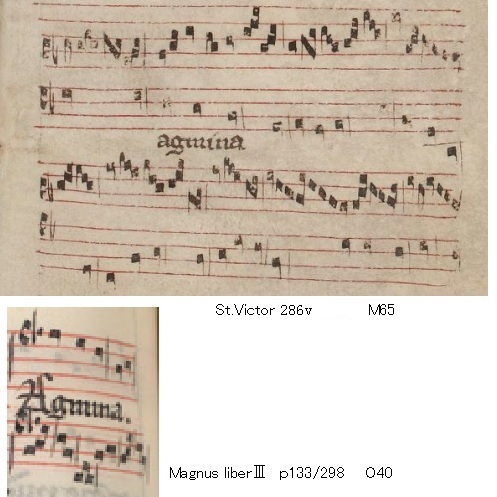 �@�A���l�ɁA���e�b�g 2.24, Locus hic terribilis/[CONFI]TE[BOR] (fols. 406v.407r, M 12)(�l�k�R�@���P�T�P�j�͂e�ʖ{���̃f�B�X�J���g�Ɗ֘A���Ă���B ����������́A�ʂ̃I���K�k��(M 51)�̃e�m�[���iET EXALTAVI�j����transmit���ꂽ���̂ł���B����ɉ����A�`�������́A�v�Q�ʖ{���ɂ��܂��c����Ă���e�ʖ{���̑����̃��e���ꃂ�e�b�g�ɂƂ��āA�v�Q�ʖ{�ɂ����ẮA�K���ȃz�X�g�I���K�k������������Ȃ����Ƃ������o���Ă���39�B�e�ʖ{����3�����e�b�g�̑命�����R���I���K�k���������Ă��邱�Ƃ����ڂ��ׂ��ł���B�e�ʖ{���̂R�����e�b�g�ɂ���Q�O�̃e�m�[���`�����g�̂����A�T��(M 14, M 32, M 51, O 2�A O 16)�݂̂��A�R���I���K�k���������Ă���B����ɁA���e���ꃂ�e�b�g�̃e�L�X�g���T��I�g�p�ɑ��ēK���ł��邩�ǂ����Ƃ�����������c���Ă���B 39�@Arlt�́A�v�Q�ʖ{�ł́AM 15, M 17, M 18, M 24, M 25, M 27, M 34�A M 38�ɑ���e�m�[����̂����������e�b�g�ɑ��āA��������I���K�k�����Ȃ��A�Ƃ��Ă���B�v�Q�ʖ{���̃I���K�k���ƃ��e�b�g�̊Ԃɑ������邱�̌��@�́A�����I�ɂ́A�قȂ����M�L�҂ɂ���Ă��Ȃ�̍��q���M�ʂ��ꂽ����ł��낤�B �@Conclusions about the liturgical performance of motets, potentially within the context of organa, must always remain speculative. Yet there is an additional explanation for the ordering of motets in F that need not rely solely upon a liturgical justification. The clustering together of clausula- and discant-related motets, and the precedence awarded to motets associated with passages of discant within organa, could also arise from an awareness of the relative dissemination or status of these related materials.42 The decision to present certain discant passages within organa might reflect a perception of these passages as �eolder�f or more widely transmitted than the music of certain independent clausulae. Many of the independent clausulae in W1, for instance, are located within organa in F, perhaps confirming that discant within organa in F comprises an earlier layer of musical material than clausulae.43 �@���e�b�g�̎��H�ɂ��Ă̌��_�́A���ݓI�ɂ̓I���K�k���̓��e�̒��ɂ��邪�A��ɐ����̈���o�Ȃ��B�e�ʖ{���̃��e�b�g�̏����ɑ��邳��Ȃ����������B����́A�T��I�K�����ɗ���Ȃ����̂ł���B�N���E�Y���֘A�E�f�B�X�J���g�֘A���e�b�g�̏W�܂��A�I���K�k�����̃f�B�X�J���g�Ɋ֘A�������e�b�g�ɗ^����ꂽ�D�揇�ʂ́A�����̊֘A����f�ނ̑��ΓI�g�U���Ԃ̔F�����琶����B�I���K�k�����̃f�B�X�J���g�̃p�b�Z�[�W���݂ւ̌���́A�����̃p�b�Z�[�W�̔F�����A�Ɨ������N���E�Y���̉��y�����h�Â��h�����L��transmit���ꂽ���f����B�v�P�ʖ{���̑����̓Ɨ������N���E�Y���́A���Ƃ��A�e�ʖ{���̃I���K�k�����Ɉʒu���Ă���B�����炭�͂e�ʖ{���̃I���K�k���̃f�B�X�J���g���N���E�Y���������������̉��y�f�ޑw���܂�ł��邱�Ƃ��m�M���Ȃ���B �@Of the twenty-seven passages of discant transmitted within organa related to motets in F, only two are unique to this manuscript. By contrast, a majority of the clausulae with corresponding motets in F�\eighteen out of a total of thirty-one�\are recorded only in F. Such patterns of dissemination are typical of F as a whole: clausulae are more often unique to this manuscript than passages of discant within organa. This is unsurprising, since F contains by far the largest collection of clausulae in any extant manuscript (with 462 clausulae in fascicle 5 alone). However, even allowing for the possible loss of other sources with similarly extensive collections of clausulae, patterns of transmission and dissemination for clausulae and discant evident across surviving thirteenth-century manuscripts are sufficiently pronounced to remain significant. �@�e�ʖ{���̂̃��e�b�g�Ɋ֘A�����I���K�k������transmit���ꂽ�f�B�X�J���g�̂Q�V�̃p�b�Z�[�W�̂����A�Q�������B�ꂱ�̎ʖ{�ɑ��݂���B�e�ʖ{���̑������郂�e�b�g�ƂƂ��ɂ��鑽���h�̃N���E�Y���Ƃ͑ΏƓI�ɁB����͂R�P�̂����̂P�W�ł��邪�B��������dissemination�p�^�[���͊T���āA�e�ʖ{�ɂ����ēT�^�I�ł���B�N���E�Y���̓I���K�k�����f�B�X�J���g�����A���т��сA���̎ʖ{�ɂ����ē��L�̂��̂ł���B����͋����ɓ�����Ȃ��B�Ȃ��Ȃ�A�e�ʖ{�͌����̎ʖ{�̒��ŁA����܂ł̂����ōő�̃N���E�Y���̃R���N�V����(with 462 clausulae in fascicle 5 alone)������ł���B�������Ȃ���A�N���E�Y���̃R���N�V�����Ƃ��đ����K�͂ł�������������Ȃ����̃\�[�X�̈편�����l����A13���I�̎ʖ{�ɋ��ʂ���N���E�Y����f�B�X�J���g�̂��߂�transmission��dissemination�̃p�^�[���́A�\���Ɏc���Ă���ƌ����悤�B Patterns of dissemination: unica clausulae and the motets at the end of the ninth fascicle in F �@That the relative dissemination of musical materials could have infuenced the organisation of motets in F is supported by closer examination, particularly of the pieces at the end of fascicle 9. Motets with related materials exclusive to F are often clustered together, and the majority appear late in the collection (see Table 6). Only four motets in the eighth fascicle have related materials unique to F, while in the ninth, sixteen have related materials found in F, but not in W1 or W2. This increase in motets with related materials recorded only in F towards the end of the ninth fascicle is accompanied by an increase in motets without surviving related materials (see Table 7). The motets towards the end of fascicle 9, then, often lack related materials or have related clausulae and discant unique to F. Significantly, many of these motets themselves are also unique to F. Not a single motet in the first motet fascicle of F is a unicum: the vast majority are also transmitted in W2 (sometimes in reduced-voice versions) and, less often, in Ma. The second motet fascicle, however, contains thirteen unica (see Table 8). �@���y�f�ނ̑��ΓI�ȓ`�d���e�ʖ{���̃��e�b�g�\���։e�����y�ڂ��Ă������Ƃ́A���ڍׂȒ����ɂ���Ă��x�������B����fascicle 9�̍Ō㕔���ɂ����āB�e�ʖ{�ɑ��ēƎ��f�ނ������e�b�g�͂����Ό݂��Ɉ�̉����A�����̓R���N�V�����̌�̕��Ŗ��炩�ɂȂ� (�\�U�Q��)�B fascicle �W�ł͂S��i�݂̂��Afascicle 9�ł͂P�U��i���AW1��W�Q�ł͂Ȃ��e�ʖ{�݂̂Ɋ֘A�f�ނ�����B fascicle�X�̍Ō�̕��̂e�ʖ{�݂̂ɋL�^���ꂽ�֘A�f�ނ������e�b�g�̂������������́A��������֘A�f�ނ������Ȃ����e�b�g�����Ă���B�i�\�V�Q�Ɓj fascicle�X�̍Ō�̕��̃��e�b�g�́A�֘A�f�ނ������Ό����Ă���A�e�ʖ{���L�̊֘A�����N���E�Y����f�B�X�J���g�������Ă���B�厖�Ȃ��Ƃ́A�����������e�b�g�̑������A���g�A�e�ʖ{�ɂ����ē��L�ł��邱�Ƃł���B�e�ʖ{���̍ŏ��̃��e�b�g���qfascicle �W�ɂ�����P��isingle)�̃��e�b�g�Ȃ̂ł͂Ȃ�unicum�Ȃ̂ł���B�����́A�v�Q�ʖ{�i�Ƃ��ɂ͐�����������ꂽ�o�[�W�����Łj���邢�͂��p�x�͏��Ȃ����l���ʖ{�ɓ`�d����Ă���Bfascicle�X�͂������Ȃ���A�P�R��unica�i�̃��e�b�g�j���܂�ł���B�i�\�W�Q�Ɓj 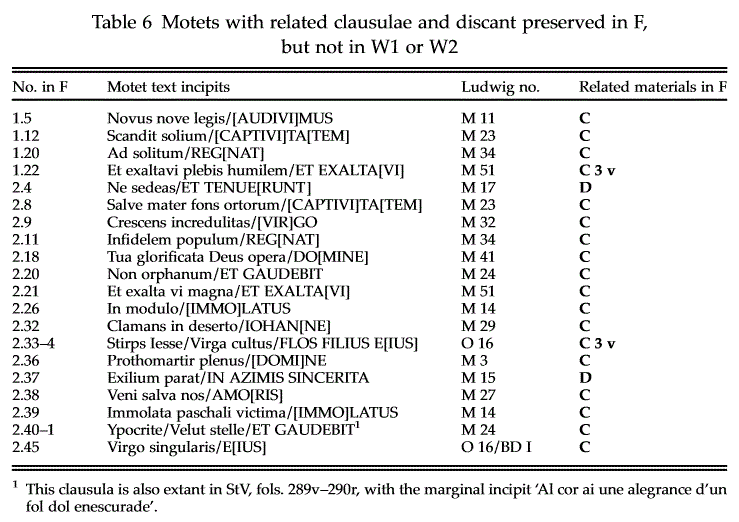 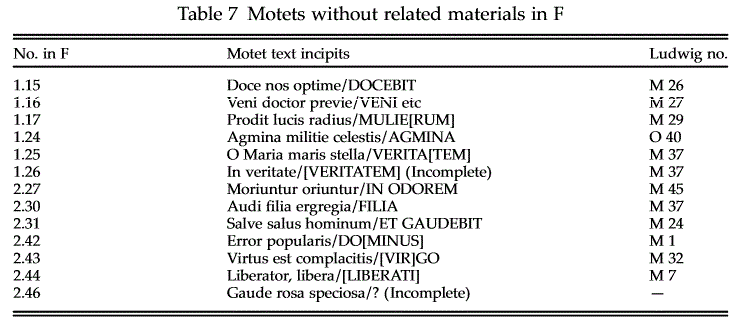 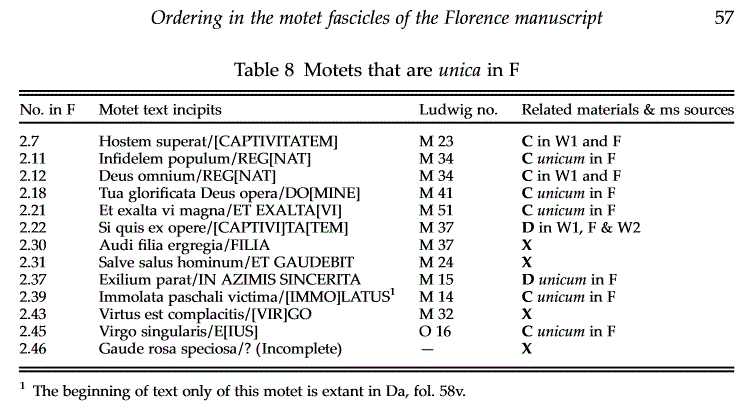 �@The correspondence between the dissemination of motets and the dissemination of their related materials apparent in Table 8 is striking. And the coincidence of motets unique to F with no related materials, or related materials also unique to F, is even more marked if one also considers the motets that are �@not strictly unica in F, but which appear in a particular texted version found only in this manuscript.44 Amongst the final motets in F, before the ninth fascicle breaks off, are eight pieces of this type: motets with texts unique to F, but whose musical material is otherwise widely disseminated and, in three cases, cited in examples by the theorist Franco of Cologne.45 These quasi-unica are interspersed with genuine unica at the end of fascicle 9, and almost all such motets have no related materials, or are related to clausulae (or, in just two instances, passages of discant) preserved in F, but not in W1 or W2. In fact, the specificity to F of the final fifteen motets in the ninth fascicle might allow these pieces to be considered as a distinct group,46 the beginning of the group marked by the first appearance in the collection of a pair of motets unique to F with no extant related materials (Table 9).47 46�@ Tischler states that the second motet fascicle in F �eclearly contains two separate collections�f (�eLatin Texts in the Early Motet Collections�f, 34), placing the beginning of his �esecond collection�fa little earlier: at motet 2.25 (Alpha bovi et leoni/DOMINO), rather than 2.30. He observes that this opening motet begins, appropriately, with the letter �eA�f, but his reasons for declaring an intentional and clearly defined �esecond collection�f at this point in the fascicle are otherwise unclear. The distinction between Tischler�fs two �ecollections�fseems to rely chiefly on patterns of concordance and transmission. On these grounds, the case for a distinct group of pieces beginning at motet 2.30 is stronger, and also takes account of the existence and transmission of related clausula and discant materials. �@���e�b�g�̓`�d��Table 8�Ŗ��炩�Ȋ֘A�f�ނ̓`�d�̊Ԃ̑Ή��́A���ڂ��ׂ����Ƃł���B�����āA�e�ʖ{���ɓƎ��ł����Ċ֘A�f�ނ������Ȃ����e�b�g�i2.30,31,43,46)�A���邢�͂�͂�e�ʖ{�ɓƎ��ł���֘A�f���i�\�U�j�̍��v�́A���������e�b�g���e�ʖ{�ɂ����Č����ɂ�unica�łȂ����A���̎ʖ{���݂̂Ɍ��������̃e�L�X�g�t���o�[�W�����Ɍ���郂�e�b�g�����l������̂ł���A���ڂ����ׂ����Ƃł���B44 �e�ʖ{���̍Ō�̃��e�b�g�Q�̊Ԃł́Afascicle�X���I������O�ɁA���̃^�C�v�̂W�̍�i������B���e�b�g�͂e�ʖ{�ɓ��L�̃e�L�X�g�������Ă��邪�A���̉��y�f�ނ͍L���`�d���ꂽ���̂ł���A�R�̃P�[�X�ł́AFranco of Cologne�ɂ���ĕ���Ƃ��Ĉ��p����Ă���B45 ��������quasi-unica �́Afascicle 9�̍Ō�ɂ���悤�Ȑ^����unica�ƂƂ��ɎU�݂��A�قƂ�ǂ��ׂẴ��e�b�g�͊֘A�����f�ނ͂������A���邢�͂e�ʖ{���ɂ͂��邪�v�P��v�Q�ʖ{�ɂ͂Ȃ��̃N���E�Y���Ƃ͊W���Ă���B�����Afascicle�X�̍Ō��15�̃��e�b�g�̓��ꐫ�́A�����̍�i��ʌ̃O���[�v�ƍl���邱�Ƃ��ł��邩������Ȃ�46�B�O���[�v�̍ŏ��̂Q��i�́A�֘A�����f�ނ������Ȃ���̃��e�b�g�̃R���N�V�����Ƃ��čŏ��ɏo�����Ă��� (Table 9)�B 46�@Tischler�́A���e�b�g 2.30�����ނ������e�b�g2.25 (Alpha bovi et leoni/DOMINO)���h��Q�R���N�V�����h�̍ŏ��Ƃ��āA�ufascicle�X�͖��炩�ɁA�ӂ��̕��������R���N�V�����ł���v�Ƃ��Ă���B�ނ́A���̃��e�b�g�́h�`�h�Ŏn�܂��Ă���Ƃ������Ƃ����邪�A�������g�́h��2�R���N�V�����h�̒�`�Ƃ��Ă��A���̓_�ȊO�ł͋敪��������Ƃ������Ƃł�����A�Əq�ׂĂ���BTischler�̂ӂ��̃R���N�V�����́A��Ƃ��āAconcordance��transmission�̃p�^�[���ɋ����Ă���Ǝv����B���������������ꂩ�猩��A ���e�b�g2.30�����̂��̍ŏ��Ƃ���O���[�v�����̕�����苭���A�N���E�Y����f�B�X�J���g�Ɋ֘A�����f�ނ̑��݂�transmission���l�����Ă���ƌ�����B�B 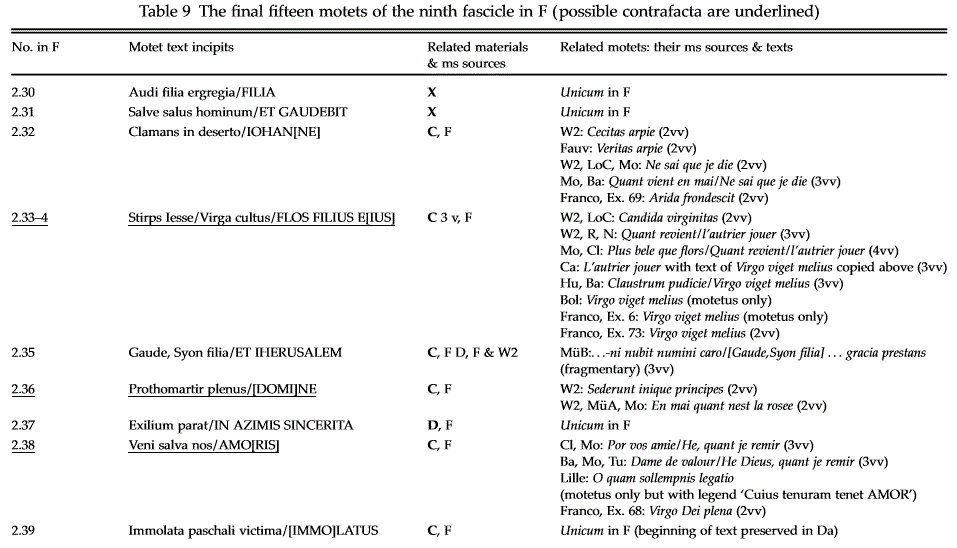  �@All fiffteen motets at the end of the ninth fascicle are either unique to F or appear in a particular version unique to F. Only two of these motets have related materials found outside F, and both are rather special cases. The clausula in F on ET GAUDEBIT, related to the double motet 2.40�]1, is also transmitted, not in W1 or W2, but in the later �eSt Victor�f collection of clausulae copied with French motet incipits.48 Similarly, for motet 2.35, the conclusion of the discant on ET IHERUSALEM in W2 differs substantially from the corresponding clausula and discant in F. In fact, motet 2.35 appears to have been created by conflating the clausula and discant versions of its related materials as they are preserved in F, and thus this unusual piece has a particular specificity to F.49 48�@ Fred Buttner has recently prosed that this clausula in StV represents a transcribed motet. See his Das Klauselrepertoire der Handschrift Saint-Victor (Paris, BN, lat. 15139): Eine Studie zur mehrstimmigen Komposition im 13. Jahrhundert (Lecce, 2011), 306?12. �@����炷�ׂĂ̂P�T�̃��e�b�g�͂e�ʖ{�����̂��̂ł���A�܂�F�ʖ{�Ǝ��̓���ȃo�[�W�����Ɍ����B�����̂����Q�i2.35,40-1�����́A�e�ʖ{�ȊO�̊֘A�f�ނ�L���Ă��āA���҂Ƃ��A�H�œ���ȃP�[�X�ł���B�e�m�[�� ET GAUDEBIT��̃N���E�Y���́A�_�u�����e�b�g2.40�]1�Ɗ֘A���A����͂v�P�C�v�Q�ł͂Ȃ��A��̂r���D�u�ʖ{�̃N���E�Y���ɓ`�d����Ă���B���̃N���E�Y���ɂ́A�t�����X��̃��e�b�g��incipit(�ŏ��̌��t�j���L����Ă���i�Ghttp://machikun.la.coocan.jp/contrafactaand1.htm�Q�Ɓj�B48 ���l�ɁA���e�b�g2.35�ɂƂ��ẮA�v�Q�ʖ{��ɂ�����e�m�[�� ET IHERUSALEM��̃f�B�X�J���g�̋A�����A�e�ʖ{���őΉ�����N���E�Y����f�B�X�J���g�Ƃ͖{���I�ɈقȂ��Ă���B�����A���e�b�g2.35�́A���̊֘A�����f�ނ̃N���E�Y���o�[�W�������邢�̓f�B�X�J���g�o�[�W�����̗Z���ɂ���č��ꂽ���Ƃ����炩�ɂȂ��Ă���B���������o�[�W�����͂e�ʖ{�ɕۑ�����Ă���A����䂦�A�����������ʂƂ͈قȂ��i�́A����ȓ��ِ��������Ă���B 48�@Fred Buttner�́AStV���̂��̃N���E�Y���́Atrascribe���ꂽ���e�b�g�ł���Ƃ����咣���ŋ߂��Ă���B �@Caution must naturally be exercised when the presence or absence of motets and clausulae in certain sources is awarded significance: unica motets and clausulae could have been copied in manuscripts now lost, and widely transmitted motets may, owing to the vagaries of source survival, be documented in a single source only. Patterns of concordances for the motets in F and their related clausulae and discant, however, seem too pronounced simply to be coincidence. The concentration at the end of fascicle 9 of motets preserved in a form unique to F, either with no related materials or with related materials unique to F, stands in such stark contrast to fascicle 8 that it can hardly result from pure chance. �@�����̃\�[�X�ɂ����郂�e�b�g��N���E�Y���̑��݂��邢�͕s�݂��d�v����^����ꂽ���ɂ́A���ӂ��������Ȃ���Ȃ�Ȃ��Bunica�̃��e�b�g��N���E�Y���́A����,�ʖ{���Ŏ����Ă��܂����ʖ{���ɃR�s�[���ꂽ�̂�������Ȃ����A�L���`�d���ꂽ���e�b�g�́A�\�[�X�����̞B����������A��̃\�[�X�݂̂ɋL���ꂽ���Ƃ��낤�B�e�ʖ{���̃��e�b�g�₻�̊֘A�����N���E�Y���A�f�B�X�J���g�̊Ԃ�concordance�p�^�[���́A�������Ȃ���A�P���ɋ��R�ɂ����Ȃ��B fascicle 9�̍Ō㕔���̏W�����́A�e�ʖ{�ŗL�ŁA���̑f�ނɊ֘A���Ăł���A���Ȃ��Ăł���A�����̋@���̌��ʂł͂قƂ�ǂȂ��i�e��i�Ƃ��悭�������Ă�ꂽ�j fascicle 8 �ɑ��鋭���R���g���X�g�������Ă���B �@In terms of compositional method, the motets at the end of the ninth fascicle are a heterogeneous collection: several of them may be textings of pre-existent clausulae or passages of discant within organa. Some are contrafacta, while others do not seem to have borrowed any existing material, but may be �enewly composed�f. The interspersion of unica and very widely disseminated pieces at the end of fascicle 9 puzzled Darwin Scott, who admitted that he sought �ein vain to discover any underlying method of organisation�f.50 Arlt, too, found the ordering of these final pieces in the motet collection of F difficult to reconcile, observing that their arrangement with regard to calendric ordering and liturgical provision appeared to be �earbitrary�f.51 The common specificity of these works and their related materials (where extant) to F might explain why such a seemingly disparate group of diverse pieces was clustered together at the end of the motet collection. �@��ȉߒ��Ɋւ��Č����Afascicle 9�̍Ō㕔���̃��e�b�g�́A�َ��Ȃ��̂̃R���N�V�����ł���ƌ�����B�����̂����̂������́A���Ƃ��Ƒ��݂��Ă����N���E�Y���̉̎��Â����ꂽ���̂�I���K�k�����f�B�X�J���g�ł��邩������Ȃ��B���̑��̂��̂́A�f�ނ��ؗp���Ă���悤�ɂ͌����Ȃ����A�V���ɍ�Ȃ��ꂽ���̂Ȃ̂ł��낤�Bunicumu�Ɣ��ɍL��disseminate���ꂽfascicle 9�̍Ō㕔���̍�i�̎U�݂́Aorganisation�̊�{�I�ȕ��@�����邽�߂ɖ��ʂɒT�����߂Ă���Darwin Scott��Y�܂����B50 Arlt���܂��A�������ƓT��K��Ɋւ��邱���̍Ō�̍�i�̏������u���ӓI�v�ł���Ǝv���邱�Ƃ��ώ@���Ȃ���AF�ʖ{�̃��e�b�g�R���N�V�����ɂ����邱���̍ŏI�I�ȕ����̏����t�����A��������̂�������Ƃ����o���Ă����B51 �e�ʖ{�ɑ��邱��������i�Q�₻���̊֘A�f�ނ̓��ꐫ�́A�Ȃ����̂悤�Ȉꌩ�قȂ��Ă���悤�Ɍ����鑽�l�ȍ�i�Q���A���e�b�g�R���N�V�����̍Ō�ň�̂ƂȂ����̂��Ƃ��������ƂȂ��Ă����B �eOld�f and �enew�f in F �@An organising principle reflecting the relative dissemination of musical textual materials is not unheard of in motet fascicles. Roesner has observed that �epresentation by relative popularity seems to obtain in some of the individual motet fascicles in Montpellier H196�f.52 Similarly, Mary Wolinski has noted an analogous progression in the motet fascicles of W2, remarking that the �efirst alphabets of French and Latin motets in W2 contain the ... most widely transmitted pieces, while the last alphabets have ... unica and contrafacts�f.53 It seems plausible, then, that motets recognised at the time of copying as specific to F, and not considered to be widely disseminated or �epopular�f, might appear towards the end of the collection. Indeed, an awareness of the pieces at the end of the ninth fascicle as particular to F could further suggest that these motets may have been newly created and re-worked specifically for F. If this were the case, such motets might represent a separate layer of pieces which were not already in general circulation and perhaps more recent than motets presented earlier in the collection. 52�@Roesner, Introduction to the �eNotre-Dame Manuscript�f F, 29. Roesner goes on to remark that �ethe criterion of relative popularity does not apply to the [motet] collection in fascicle 9 [of F], since these are among the most widely disseminated works in the repertory, and also among the most reworked�f (29). He is seemingly unaware that many of these widely disseminated works appear in F in a version extant only in this source and that they are interspersed with unica. �@���y�̃e�L�X�g�f�ނ̑��ΓI�`�d�f����\�������́A���e�b�g���q���ł͂��܂�m���Ă��Ȃ��BRoesner�́A���ΓI�Ȑl�C�ɂ��presentation �́A�����y���G�ʖ{���̂������̌X�̃��e�b�g���q�ɂ����ē�����悤�Ɏv����Ƃ��Ă���B52 ���l�ɁAMary Wolinski�́A�uW2�ʖ{���̃t�����X��A���e���ꃂ�e�b�g�̍ŏ��̃A���t�@�x�b�g�́A�����Ƃ��L���`��������i���܂�ł���B�Ō�̃A���t�@�x�b�g��unicum��contrafacta�̂��̂ł���v�ƌ����Ȃ���AW2�̃��e�b�g���q�ɂ�����̂Ɠ��l�̐i�����L�q���Ă����B53 F�ʖ{�ɓ��L�̂��̂Ƃ��ĕM�ʂ��ꂽ���_�ŔF������A�L�����y������l�C������Ƃ͎v���Ȃ����e�b�g�́A�R���N�V�����̍Ō�ɏo������\���͂������ɂ���Ǝv����B�܂����������āAF�ʖ{�ɓ��L�̂��̂Ƃ��Ă�fascicle9�̍Ō�̍�i�̔F���́A�����������e�b�g���V���ɍ��ꂽ��AF�ʖ{�ɓ����I�ɂ�����re-work���ꂽ��Ƃ��������Ƃ������B���̂悤�ȏꍇ�A���̂悤�ȃ��e�b�g�́A���łɈ�ʂɂ͗��ʂ��Ă��Ȃ��������ꂽ��̍�i��\���A�����炭�ȑO�̓R���N�V�����Ɍf�ڂ���Ă������e�b�g�����V�����̂�������Ȃ��B 52�@Roesner�́A�u���ΓI�l�C�̊��fascicle 9�̃��e�b�g�R���N�V�����ɂ͓K�p����Ȃ��B�Ȃ��Ȃ�A�����̓��p�[�g���[�Ƃ��Ă����Ƃ��L���`�����ꂽ��i�ł���A�܂������Ƃ�re-work���ꂽ��i�ł����邩��ł���v�Ɩ������Ă����B�ނ́A�ꌩ���āA�����̓`�����ꂽ��i��F�ʖ{���̃o�[�W�����݂̂Ɍ���A����ɂ͂�����unica�ƂƂ��ɎU�݂������ƂɋC�Â��Ă��Ȃ��B �@It would be appropriate that works relatively �enew�fat the time when F was compiled should appear near the end of the collection. This has been noted already by Roesner: �@F�ʖ{���Ҏ[���ꂽ���ɑ��ΓI�ɐV����������i���R���N�V�����̍Ō�̕��ɏo�����邱�Ƃ͓K���Ȃ��Ƃł���B���̂��Ƃ͂��łɁARoesner�ɂ���Č����Ă���B �@There is also an overall progression from old to new, with the more recent genre of the motet appearing late in the manuscript (in fascicles 8 and 9) and, again, the presumably relatively modern refrain songs coming at the end (fascicle 11). Similarly, within the strictly liturgical section, the clausulae that for the most part represent reworkings of an earlier corpus of organa are placed after their respective repertories.54 54�@Roesner, Introduction to the �eNotre-Dame Manuscript�f F, 25. Internally, however, fascicle 5 may enact a progression in the opposite direction. Baltzer has noted that �ethe newest and largest collection is given pride of place, and the second and third/fourth series betray increasing age�f. See Les clausules a` deux voix du manuscrit F, xliv. �@fascicles 8 �� 9�ɂ����āA�ォ��o�����郂�e�b�g�̂��V��������ƂƂ��ɁA�V�������̂���Â����̂ւ̑S�̓I�Ȑi��������B�����āA���V����refrain�̂���̂��Ō��ifascicle 11�j������Ă���B���l�ɁA�����ȓT��I����ł́A���̑啔�����I���K�k����earlier corpus ��re-work�ł���N���E�Y���́A���ꂼ��̃��p�[�g���[�̂��Ƃɒu����Ă���B 54�@Roesner�́A�������Ȃ���A�����I�ɂ́Afascicle 5�͔��Ε����ɐi�s���Ă�����������Ȃ��A�Ƃ��Ă���BBaltzer�́A�����Ƃ��V�����傫�ȃR���N�V�����͏ꏊ�ɂ��v���C�h���^������B�����āA�Q�A�R�C�S�Ԗڂ͔N�𑝂₷���������A�Əq�ׂĂ���B �@The association of motets at the end of fascicle 9 predominantly with independent clausulae�\which apparently did not circulate widely outside F�\rather than passages of discant transmitted within organa, could be further confirmation of their relative dissemination and novelty. �@�Ɨ������N���E�Y���i���炩��F�ʖ{�O�ւ͏z���Ă��Ȃ����j�ƌ��т���fascicle 9�̍Ō�ł̃��e�b�g�̘A���̂́A�I���K�k�����ɓ`�d���ꂽ�f�B�X�J���g�����A�����̑��ΓI�`�d�Ɗv�V���̂���Ȃ�m�M�ƂȂ������Ƃł��낤�B Lacunae in the motet fascicles of F �@These observations about the nature of the motet collection in F might shed further light on the possible lacunae in this manuscript. Both fascicles 8 and 9 are incomplete, breaking off mid-motet at the end of the single gatherings that constitute each fascicle. The original foliation of F ends in the middle of fascicle 7, therefore it remains unknown how many further gatherings of motets, if any, may have been intended. As the extant contents of fascicle 8 span the entire liturgical year, would this cycle have simply broken down if the fascicle continued (as it seemingly begins to do at the end of the first gathering)? Or would there have been a second supplementary liturgical cycle of motets, in the same manner as the clausula cycles recorded in fascicle 5? And would a second gathering at the end of fascicle 9 have continued to present motets that were perhaps relatively recent or specific to F as a source? Roesner has also emphasised that F may conceivably be missing not only gatherings of motets but also entire fascicles, which would, he suggests, most likely have recorded Latin double motets and could even have contained motets with French texts.55 �@F�ʖ{���̃��e�b�g�R���N�V�����̐����̂��������ώ@�́A���̎ʖ{�ɂ�����E�������ɂ����ĂĂ݂邱�Ƃ��낤�Bfascicles 8�� 9�o���͕s���S�ł���A���ꂼ����\������P���gathering�̍Ō�ɂ͒E�����������݂���BF�ʖ{�̌��X��foliation��fascicle 7�̒��ԂŏI����Ă����B����䂦�A���Ƃǂꂭ�炢�̃��e�b�g��gathering�����邩�́A�킩��Ȃ��܂܂ɂȂ��Ă���B���������ꂪ����A����͈Ӑ}���ꂽ���̂ł��������낤�B �����c����Ă���fascicle 8�̓��e�͓T��N�S�̂Ɍׂ��Ă��邪�A���̃T�C�N���́A���������q�������Ă����Ȃ�i�ŏ���gahering�ɑ����n�߂�悤�Ɍ������Ƃ��Ă��j�A�P���ɉ�Ă��܂��Ă����̂ł͂Ȃ����H�@���邢�́Afascicle 5�ɋL�^���ꂽ�N���E�Y���T�C�N���Ɠ����悤�ȕ��@�ŁA���e�b�g�̑�Q�̕⏕�I�ȓT��T�C�N�����������ł��낤���H�@�����āAfascicle 9�̍Ō�̑�2gatherin���́A�\�[�X�Ƃ���F�ʖ{�ɓ��ٓI�ł��郂�e�b�g�ɑ������Ƃ͂ł����ł��낤���H�@ Roesner���܂��AF�ʖ{�̓��e�b�g�̂�gathering�����łȂ��A�S�̂̍��q���������Ă���\��������A�Ƌ������Ă���B�ނ́A�����������q�́A���e����̃_�u�����e�b�g���L�^���A�t�����X��e�L�X�g�̃��e�b�g�����܂�ł������낤�A�ƍl���Ă���B �@It is arguable, however, that the motet collection as now extant in F is, in fact, essentially complete. Perhaps the scribe did not wish to waste an entire new gathering simply because the piece(s) intended for the end of these fascicles did not fit onto the final verso.56 �@�������Ȃ���A����F�ʖ{�Ɏc����Ă��郂�e�b�g�R���N�V�������A���ۊ��S�Ȃ̂��ǂ����́A�c�_���������Ƃ���ł���B�����炭��҂͑S�̓I�ȐV����gathering�̔p���͊���Ă��Ȃ������ł��낤�B�Ȃ��Ȃ�P���ɁA�������q�̏I���ɂȂ�͂���������i�͍Ō��verse�ɓK�����Ă��Ȃ���������ł���56�B 56 Admittedly, this does not seem to occur elsewhere. All other fascicles in F end with unfilled folios, save�@fascicles 2 and 5, which break off mid-clausula (but where it is evident from the original foliation that�@leaves are now missing). 56�@���炩�ɁA�����������Ƃ́A���̏ꏊ�ł͋N����Ȃ������BF�ʖ{���̑��̍��q���ׂẮAfascicles 2 and 5�������āA�N���E�Y����r���Œf����悤�ȁA���ׂĂ�����ƏI����Ă��Ȃ�folio�ł���B It is difficult to imagine how fascicle 8 could have continued: the idea of a second gathering that did not follow the liturgical calendar may be unlikely in view of the strict liturgical organisation of the first. From the evidence of surviving thirteenth-century sources, there are few monotextual motets not already included in F that could have made up such a second liturgical cycle. As Scott has noted, the eighth fascicle of F �euniquely preserves as an entity nearly the complete extant Parisian repertory of this type of motet�f.57 fascicle 8���ǂꂭ�炢�����Ă�������z�����邱�Ƃ͍���ł���B�����ɏ]���Ă��Ȃ���Q��gathering�̗��z�͍ŏ��̕��̌����ȓT��I�ȍ\���Ƃ����ϓ_����͂܂������قȂ������̂�������Ȃ��B�P�R���I�̃\�[�X�Ƃ��Ďc���Ă���؋�����́A��Q�̓T��T�C�N�������グ�邱�Ƃ��ł���悤��F�ʖ{�ɂ��łɊ܂܂�Ă����P��̎��̃��e�b�g�͂قƂ�ǂȂ��B Scott���L�����悤�ɁA fascicle�W�́A�u��������p�����̃��e�b�g�����S�ɋ߂��`�Ŏc���Ă���B��̑��݂ł����v�B57 Norman Smith has also emphasised the comprehensive nature of the motet collection in F, observing that this manuscript records �eall but seven of the first-mode Latin clausula-based repertory motets�f.58 Norman Smith ���܂��A����F�ʖ{�����e�b�g�̃��p�[�g���[����b�ɂ����V�̑�P���[�h�̃��e����N���E�Y���ȊO���ׂĂ��L�^���Ă��邱�Ƃ��ώ@���Ȃ���A���̃��e�b�g�R���N�V�����̕�I�Ȑ��������������B58 Furthermore, if the motets at the end of fascicle 9 comprise a group of works specific to F, then their appearance at the end of the collection would be appropriate, and it is questionable whether another further gathering could have been filled with many more such pieces. ����ɂ����A������fascicle 9�̍Ō�̃��e�b�g���ʖ{�ɑ��ē���ȓ����ƂȂ�O���[�v���\�����Ă���Ƃ�����A���̎��A�R���N�V�����̍Ō�̂��������͓K���ƂȂ������Ƃ��낤�B�����āA������̂���Ȃ�gathering����葽���̍�i�Ŗ������ꂽ���ǂ����͋^��ł���B �@It seems also relatively improbable that fascicles of double or French motets may be missing from F. Had there been a gathering devoted to double motets, then the three pieces of this type recorded amongst the two-voice motets in fascicle 9 would surely have appeared here instead. F as a whole does not contain any vernacular texts and principally employs ordering systems more commonly associated with purely Latin liturgical sources. Indeed, the presence in F of a number of widely transmitted French motets in versions with unique Latin contrafacta might indicate that the better-known French texts were deliberately avoided in this manuscript. Such propositions necessarily remain hypothetical, but they are supported by the nature of F as a source, and the organisational conventions and patterns of transmission in its motet fascicles. �@�_�u���܂��̓t�����X�ꃂ�e�b�g�̍��q��F�ʖ{���玸���Ă��邩������Ȃ����Ƃ́A���܂肠�蓾�������Ȃ��B�������_�u�����e�b�g���W�܂���gathering�������ɂ������̂Ȃ�Afascicle 9 ���̂Q���̃��e�b�g�ɑ��ċL�^���ꂽ���̃^�C�v�̂R��i�́A�m����,�m���ɂ����Ɍ��ꂽ���Ƃ��낤�B�T����F�ʖ{�͐����I�̎����܂�ł��炸�A�����ȃ��e����̓T��̂��߂̃\�[�X�Ɉ�ʓI�Ɋ֘A���������V�X�e���������Ƃ��Ďg�����Ƃ��낤�B ����ɁAF�ʖ{���̑�����transmit���ꂽ�t�����X�ꃂ�e�b�g�i���̒��Ƀ��j�[�N�ȃ��e�����contrafacta���܂ށj�̑��݂́A���悭�m��ꂽ�t�����X��̎������̎ʖ{�ł͒��d�ɔ������Ă����A�Ƃ������Ƃ�������������Ȃ��B���������l���͂܂������̗̈���o�Ȃ����A�������A�����������Ƃ́A�\�[�X�Ƃ��Ă�F�ʖ{�̐�����\���I���n��A���e�b�g���q����transmission�̃p�^�[���ɂ���Ďx�������B �@In conclusion, it appears that the two fascicles containing monotextual, two-voice and polytextual three-voice motets in F were ordered very carefully, under a number of shared organisational principles. Both motet fascicles exhibit the influence of the liturgical calendar, and both appear to reflect an awareness of the presence and type of related clausula or discant material recorded elsewhere in the manuscript. This could be interpreted as evidence of a liturgical function for the motets of F. Yet it might also be explained by the proposition that those compiling F were mindful of the relative age of musical material: of the motets themselves and their related passages of discant transmitted within organa or clausulae. Ideas of age and �epopularity�f may, therefore, have further influenced the arrangement of the motet fascicles in F, which broadly enact an over-arching progression from old to new, from widely disseminated motets with widely disseminated related materials to those whose music and/or texts are specific to this source. �@���_�Ƃ��āA�P��̎��A�Q���A�R�����e�b�g���܂ޓ�̍��q�́A���L���ꂽ�@�\�I�����̂��ƂŁA���ɒ��Ӑ[���������Ă��Ă������Ƃ����炩�ɂȂ�B�ӂ��̃��e�b�g���q�́A�T���̉e���������A���҂͌���ӎ��ƁA�ʖ{�̂ǂ����ŋL�^���ꂽ�֘A����N���E�Y����f�B�X�J���g�̑f�ނf���Ă���B����́AF�ʖ{�ɂ�����T��I�@�\�̏؋��Ƃ��āA���߂���邱�Ƃ��ł���B ����ɁA��������F�ʖ{�̕Ҏ[�͉��y�f�ނ̑��ΓI�Ȏ���ւ̋C�z�肪�������Ƃ�����������ł���B���e�b�g���g�ɂ��āA����ɂ̓I���K�k������transmit���ꂽ�f�B�X�J���g��N���E�Y���Ɋ֘A���āB�����l�C�̗��z�͂���䂦�A�����F�ʖ{���̃��e�b�g�̔z��ɉe�����y�ڂ����Ƃ��낤�B����͍L���Â�����V�����܂ł̍L���i�����s���B�L�͂ɕ��y���Ă���֘A�f�ނ��܂ލL�͂ɕ��y�������e�b�g����A���y��e�L�X�g�����̃\�[�X�ɓ��L�̃��e�b�g�܂ŁB �@Such findings have considerable consequences for the study of thirteenth-century manuscripts preserving organa, clausulae and motets. They underline the importance of the generic distinction between clausulae and passages of discant within organa, and the association of concepts of relative age and dissemination with these different musical types. Sensitivity to chronological layers evident in the compilation of F also supports the generally accepted hypothesis that this manuscript post-dates much of the musical repertoire it contains:59 the relative popularity of motets, clausulae and passages of discant within organa was evidently already established by the time F was created in the 1240s. It remains to be seen whether the remarkably assiduous arrangement of motets in F is particular to this source. The very fact that F was copied by a single music scribe sets it apart from W1 and W2, both products of multiple copyists.60 Was such a high degree of organisation an idiosyncratic concern of those producing F? If so, this scribal care and consistency might reflect the importance and prestige of F, a consequence perhaps of its close connections with the cathedral of Notre Dame, or of its possible status as a Magnus liber organi. �@���̂悤�Ȕ����́A�I���K�k���A�N���E�Y���A���e�b�g��ۑ����Ă���13���I�̎ʖ{�̌����ɑ傫�ȉe����^���Ă���B�����́A�N���E�Y���ƃI���K�k�����̃f�B�X�J���g�̃p�b�Z�[�W�Ƃ̊Ԃ̈�ʓI�ȋ�ʂ̏d�v���ƁA���ΓI����̊T�O�Ƃ����̈قȂ������y�l�����`�d�Ƃ̏d�v�����������Ă���B F�ʖ{�̕Ҏ[�Ŗ��炩�ɂ��ꂽ���n��I��layer�ւ̊��͂܂��A���̎ʖ{���A���̉��y�I���e������ɋL�������̂ł����Ƃ��������̗��t�����x�����Ă���B�F59�@�e�ʖ{�̎���܂łɊm�����ꂽ���e�b�g�A�N���E�Y���A�I���K�k�����f�B�X�J���g�̑��ΓI�Ȑl�C�͖��炩�� �i�̂��̎���́j1240�N��ɍ��ꂽ�̂ł���B F�ʖ{���̃��e�b�g�̌����ŊԒf�Ȃ��z�u�����̃\�[�X�ɓ��L�ł��邩�ǂ����͂܂��������Ă��Ȃ��BF�ʖ{��1�l�̃X�N���C�u�ɂ���ĕM�ʂ��ꂽ�Ƃ��������́A�����̃X�N���C�u�̎Y���ł���ł���W1�ʖ{�����W2�ʖ{��ʕ��Ƃ���B60 ���̂悤�ȍ��x�ȋ@�\�́AF�ʖ{�Y����@�\�̓��L�̌��O�ł��������H �����ł���A���̕M�L��̒��ӂƈ�ѐ��́A�����炭�m�[�g���_���吹���Ƃ̖��ڂȌ��т���AMagnus liber organi�Ƃ��Ẳ\�Ȓn�ʂ̌��ʂƂ��ẮAF�̏d�v���ƈАM�f���邩������Ȃ��B 1 (f. 1-13): 6 four-part works and 9 three-part clausulae; 2 (f. 14-67): 26 organa, 5 clausulae, 1 organum, 1 clausula, 1 organum, all a 3 ; �R (f. 65-98) : 32 organa from the magnus liber organi de antiphonario, 7 Benedicamus, 8 Domino clausulae, 4 Benedicamus and 3 more organa, all a 2 �S (f. 99 -146): 61 two-part organa from the magnus liber organi de graduali; �T (f. 147-184): 462 two-part clausulae; �U (f. 201-262): 59 three-part conductus and 2 four-part conductus-motets ; �V (f. 263-380): 130 two-part conductus; �W (f. 381-398): 26 three-part conductus-motets (25 in two-part score followed by the T + 1 in three-part score) ; �X (f. 399-414) : 40 two-part and 3 three-part motets written in separate parts ; �P�O (f. 415-462) : 83 monodic conductus; �P�P (f. 463-476): 60 monodic Rondelli. As compared with W1, F often employs a breve shape instead of a long in unison passages, while the opening tuning-note is written as a double long instead of 2 unison longs. |